
LANCERSHIRE FUSILIERS.
Private: 7766 Harold TRICKETT.
Born:
Married:
Wife: nee:.
Died: Australia.
Father:
Mother: nee:.


Under Construction 10/02/2009-22/01/2018.
9th Infantry Brigade Aif | Online Research Library & Membership site.

Born:
Married:
Wife: nee:.
Died: Australia.
Father:
Mother: nee:.


Under Construction 10/02/2009-22/01/2018.

Born: 20th June 1893. Brisbane, Queensland, Australia.
Died: 15th August 1915. Killed in Action Gallipoli, Ottoman Empire (Turkey).
Father: Edward Francis Donkin. (28/05/1849-27/05/1910) Born Boulogne, France.
Mother: Grace Donkin. nee: Lyons. (13/01/1868-19/09/1921) Born Sale, Victoria.
Cemetery or memorial details: Lone Pine Memorial, Gallipoli Peninsula, Canakkale Province, Turkey. Aged 24 years.
20th December 1915.
Informant; Sergeant: 669 M MCLAUCHLAN. B Company, 1st Battalion AIF. "When receiving his first lesson in the use of a Machine Gun in an old trench to the rear of Lone Pine, to which he had only just been transferred, a fragment of a 75 shell Killed him instantly. Information received from several in company".
Gezira Hospital, CAIRO.
29th December 1915.
Informant; Private: 736 S.O. SIMPSON 1st Battalion AIF. "Informant was close to DONKIN at the Machine-Gun in the first trench from the ANZAC BEACH when he was hit in the head with a piece of shell and Killed during the first week of August."
1st Australian General Hospital, Heliopis, CAIRO.
30th March 1916.
Informant; Private: 762 W WILDES 1st Battalion AIF. "While in the trenches facing JOHNSON'S JOLLY to the left of LONE PINE, DONKIN was struck by a fragment of a shell and Killed instantly. Informant was alongside at the time. This was a week after the charge at LONE PINE. DONKIN was buried in SHRAPNEL GULLY".
4th Australian General Hospital, RANDWICK, N.S.W.
18th April 1916.
Informant; Lance Corporal: 696 W.G.FROST 1st Battalion AIF. "About 15th August, DONKIN was shot in the head while working a Machine Gun at LONE PINE. Informant saw his body buried the following night, just behind our trenches at LONE PINE. DONKIN was of medium height, young, auburn complexion, light build".
4th Australian General Hospital, RANDWICK, N.S.W.




Family Information
Reg was a single 23 year old Labourer from East Maitland, N.S.W. upon enlistment. He served with the 4th Battalion Infantry Militia prior to enlisting with the AIF. Edward and Grace Donkin were married in Queensland? and had at least 9 children. Myrtle Donkin born 1892 Queensland Cert:11469 and died 1892 Queensland Cert:3818. Ivy Donkin born 01/03/1894 Brunswick Victoria and died 02/04/1894 Brunswick, Victoria. Reginald Lyons Donkin born 1895. Brisbane, Queensland and died 15th August 1915 Gallipoli. Arthur Henry Donkin born Brisbane, Queensland and died 1965 at Sydney, N.S.W. Death Cert:5082/1965. Frank Stanley Donkin born 1899 at Burwood, N.S.W. Birth Cert:29238/1899 and died 1901 at Randwick, N.S.W. Death Cert:6806/1901. Phillip Malcolm Donkin born 05/06/1901 at Randwick, N.S.W. Birth Cert:25763/1901 and died 02/11/1921 at Rabbit Island, N.S.W. . Barbara Frederica Donkin born 1903 at Mosman, N.S.W. Birth Cert:13915/1903 and died 27/03/1986 Wyee, N.S.W. Ada C Donkin born 1905 at Ashfield, N.S.W. Birth Cert:1067/1905. Roy Stanley Donkin born 1908 at Kogarah, N.S.W. Birth Cert:4656/1908 and died 1967 at Burwood, N.S.W. Death Cert:39756/1967.
Australian War Memorial Collection relating to the service of 817 Private Reginald Lyons Donkin, 1 Battalion, AIF, at sea, Egypt, Gallipoli, 1914-1915. Collection consists of a typescript copy of a diary kept by Private Donkin between October 1914 and December 1915; a typescript copy of an urgent telegram sent to Archdeacon Tollis of East Maitland, conveying the news of Donkin's death; and a typescript copy of a letter of condolence sent to Donkin's mother by her nephew Private Roy Anderson, 7 Battalion, AIF. Copies made in 1930, in Melbourne. Location of originals unknown.
Summary
The collection is notable for the vivid and detailed descriptions Donkin gives of his experiences on Gallipoli in general, and of the Landing at Anzac Cove and the first days of the Battle of Lone Pine in particular.
Memorial Plaque for Reginald Lyons DONKIN was issued to his sister Miss Grace Donkin on the 3rd November 1921. This plaque was donated to the collection by Dawn Jackson of Pelican, N.S.W. in April 2014 and will be on display at Swansea RSL. The Memorial Plaque was above the door of a caravan on the Jackson's property for many years which was on the property when they purchased it.

Great Grandfather, Lieutenant General: Sir Rufan Shaw DONKIN. GCH KCB FRS FRGS.
(1772-1841)
In full regalia with his hand on an ivory-handled Mughal/Indian sword, wearing Knight of the Garter insignia and the Guelphic Order.
Sir Rufane Shaw Donkin, (1773–1841), army officer, belonged to a respectable Northumbrian family, said to be of Scottish descent, and originally named Duncan. His father, General Robert Donkin (1726/7–1821), served in Flanders, the West Indies, Ireland, and America, was reputedly a personal friend of the historian David Hume, and published two books about his military experiences. In 1772 he married Mary, daughter of the Revd Emanuel Collins. Rufane Shaw was the eldest of their three children, and the only son. General Robert Donkin had served with many famous British commanders including Wolfe and Gage and his Colonel, William Rufane. Young Rufane was baptised at St David's Church, Exeter on 9 October 1772 with the name Rusaw Shaw Donkin.
On 21 March 1778 Rufane was appointed to an ensigncy in the 44th foot, in which his father then held the rank of major, advancing to lieutenant on 9 September 1779 through purely paper transactions. He was educated at Westminster School in London until the age of fourteen and appears afterwards to have been a diligent student. At one time when on leave from his regiment—probably after its return from Canada in 1786—he studied classics and mathematics in France for a year, and when on detachment in the Isle of Man, read Greek for a year and a half with a Cambridge graduate. He obtained his company on 31 May 1793, and became Captain and in September he sailed for the West Indies with the flank companies of the 44th foot to be involved in the capture of Martinique, Guadeloupe, and St Lucia, and the subsequent loss of Guadeloupe in 1794.
After his return to England he was brigade major, and for several months aide-de-camp, to Major-General Thomas Musgrave, commanding at Newcastle upon Tyne, and advanced to major on 1 September 1795. He went back with the regiment to the West Indies in Lieutenant-General Sir Ralph Abercromby's expedition, which in April and May 1796 recaptured St Lucia (which had been again occupied by the French in 1795); here the 44th lost 20 officers and over 800 men, chiefly from fever. He gained the rank of Major in 1796.
Donkin was removed to Martinique unconscious and afterwards invalided home dangerously ill. Having recovered, in May 1798 Donkin was detached from the regiment to command a provisional light battalion, composed of the light companies 11th foot, 23rd Royal Welch Fusiliers, and 49th foot, with Major-General Eyre Coote's expedition to Ostend, which sought to destroy the basin, gates, and sluices of the Bruges Canal, thus hampering the concentration of French troops for an invasion of England. On 20 May Donkin distinguished himself in an action near Ostend, in which he was wounded and taken prisoner but earned Coote's special praise for his conduct. He transferred to the 11th foot as lieutenant-colonel on 24 May and joined it in temporary captivity near Douai.
In 1799 the 11th sailed for the West Indies, but a regimental historian, quoting an official War Office record that he was 'in London on regimental duty' during December 1799, has noted that 'no evidence' exists for his having served in the West Indies in 1799–1800, as claimed in the Dictionary of National Biography (Robinson, 284). There is no doubt, however, that he did command the regiment there in 1801, when the 11th took part in the capture of numerous islands, which were returned to France after the peace of Amiens. On 29 April 1802 Donkin proposed that convicts who had opted to serve in the West Indies should not be kept there for life but be allowed to serve a normal term of engagement with a regiment, once they had proved their good conduct; this change was authorized by the War Office on 18 April 1803. His regiment remained in the West Indies but in May 1804 was declared 'unfit for service' (ibid., 292), having suffered severe loss through disease, and Donkin himself left on sick leave later that year.
On 16 May 1805 Donkin was appointed to the permanent staff of the quartermaster-general's department, serving as an assistant quartermaster-general in Kent, and then with the Copenhagen expedition of 1807. In 1808 he issued a reprint of the French text of Comte L'Espinasse's Essai sur l'artillerie (1800), which was translated into English forty years later. Meanwhile, he had been promoted colonel, on 25 April 1808, and in 1809 was appointed assistant quartermaster-general with the army in Portugal. As a colonel on the staff he commanded a brigade in the operations on the River Douro and at the battle of Talavera (for which he received a gold medal), but he soon returned home and was subsequently appointed quartermaster-general in Sicily. He served in that capacity in Sicily, and also in the operations in 1810–13 on the east coast of Spain where he was initially blamed for Lieutenant-General Sir John Murray's disaster at Tarragona in 1813. However, evidence at Murray's court martial showed that the general had disregarded Donkin's views, and he was vindicated. After a short period on half pay, Donkin, who had become major-general on 4 June 1811, was next appointed to a command in the Essex district, and in July 1815 to one at Madras, from which he was afterwards transferred to the Bengal presidency. Before leaving England he had married, on 1 May 1815, Elizabeth Markham (1789/90–1818), the eldest daughter of Dr Markham, dean of York, and granddaughter of Archbishop Markham.
In India Donkin commanded the 2nd field division of the grand army under the marquess of Hastings in the operations against the Marathas in 1817–18, and by skilful movements cut off the line of retreat of the enemy towards the north. He was appointed KCB on 14 October 1818, though, unfortunately, his wife died at Meerut, aged twenty-eight, on 21 August 1818, leaving him with an infant son. Elizabeth died of a fever at Meerut, leaving a son, George David, aged only eight months. Unable to care for this young child alone, he was sent to England to be cared for by his grandfather, the Dean of York. Much shattered in health, body, and mind, he was invalided to the Cape. While there, he was requested to assume the government of the colony during the absence of Lord Charles Somerset, and did so in 1820–21, his name being meanwhile retained on the Bengal establishment. His first decision was to accept the request from the Captain of the sloop HMS Menai to assist with the landing of the settlers in Algoa Bay. To this end, Moresby set sail for Algoa Bay from Cape Town during March 1820.
During April 1820, Donkin amended Somerset’s original plan for the location of the Settlers. When Somerset had earlier intimated to Bird, the Colonial Secretary, that he wished to segregate the Settlers by nationality, Donkin misunderstood that comment to provide him with carte blanche to locate the settlers anywhere in the Cape and not necessarily, as Somerset had implied, at a different location on the Eastern Border. The effect of this change was to defeat the primary purpose of the whole Scheme which was to provide a bulwark against the Xhosa tribes on the eastern frontier.
This error in judgement was to be further compounded when a Magistrate, Daniel Johannes van Ryneveld, who had previously been the deputy Landdrost at Clanwilliam, commented favourably on this district to Donkin. Based upon this unwelcome news, the Colonial Secretary, Colonel Bird, despatched his brother-in-law, Mr Buissine, a Land Surveyor, to survey the area. Afterwards, Buissine was to compile a report on the Crown Land available in the area. To fulfil his commitments to the settlers, Donkin required 100 acres of land to be issued as a grant to adult male settlers. In his report, Buissine stated that there was only sufficient land for 80 families whereas the estimated number of families believed to be on board the East Indian and the Fanny was of the order of 125.
Even before receiving the report from Buissine, Donkin wrote to Lord Bathhurst informing him that all the Settlers from Cork would be accommodated at Clanwilliam. Donkin then left for the Zuurveld on the Eastern Border. This lamentable cascade of events had doomed the Irish settlement a priori. For the Irish, their journey of thirteen weeks ended on Sunday 30thApril 1820 at Simons Bay – now Simonstown.
On the 6th June 1820, Sir Rufane Donkin arrived in the unnamed hamlet on the shores of Algoa Bay where the Settlers had commenced landing from the 10th April 1820. His role was to superintend the settlement of the immigrants to the Cape. It was on this day that he named the embryonic town after his late wife, Elizabeth.
Envisioning that a seaport would be required to a developing interior, Donkin offered land in the nascent town to settlers who possessed capital to acquire it. To this end, he authorised the surveyor, James Swan, to prepare a plan of the lots available to those wanting to settle here. Donkin granted 1,300 acres of land north of the Papenkuils River to Charles Gurney and the settlers from Deal in Kent. This group of boatmen planned to establish a fishing village. Two of the party returned to England to acquire whaleboats but the venture was not successful being declared insolvent by August 1828.
Moresby continued to provide assistance to the arriving settlers. In gratitude, Moresby was granted a large piece of land in the Baakens Valley, which was later known as Rufane Vale, and a building facing the sea was granted to him. A house, to be named Markham House, was commenced on the erf and Donkin laid the foundation stone.
Captain Sir Fairfax MoresbyDuring August 1820, Donkin selected a prominent site for use as a memorial to his wife. A Settler draughtsman, Thomas Willson, made drawings for a pyramid similar to that of Caius Cestius in Rome and Willem Reed supplied the stone. The builders were soldiers from the Fort. In June 1821, Knobel surveyed 5 morgen 535 sq roods [4 hectares] of land around the memorial which was to remain an open space in perpetuity. The Pyramid is approximately 10 meters high and the sides at the base measure about 8 meters each. It was declared a National Monument on the 8th July 1938.
“It was Donkin who realised that a port was going to be needed on this part of the coast and took the first steps to establish one, naming this prospective village after his wife. He set aside land on the hill overlooking the bay to be forever an open space and the site of a memorial. His choice of a pyramid is not at all unusual for the time and the proportions are those of the memorial to Gaius Cestius in Rome and the architect Hawksmoor’s pyramid in the grounds of Castle Howard in Yorkshire, to name only two, and have nothing whatsoever to do with Egypt. In addition, of course, it was also an uncomplicated structure for the soldiers, who had to build it of the local sandstone."
The pyramid bears an inscription which is a touching testimony to Donkin’s love for his wife. There is, however, no truth in an often repeated rumour that her heart lies buried under the pyramid. Although he did, in fact, carry her heart away from India, it was buried in England. Returning to the Donkin/Duncan family: since coat-armour, like tartan, is tied to a family name, the Duncans have not only a different tartan from the Robertsons, but also a different coat of arms. Since any coat of arms is the property of only one person at any one time, different branches of the family bear different versions of that coat of arms.
ALTHOUGH General Sir Rufane Shaw Donkin left no descendants at the Cape and only spent a couple of years in the colony, the adoption of his arms in 1861 by the town of Port Elizabeth (which he had founded in 1820) has left an abiding influence in the heraldry of the Algoa Bay region.
He seems to have been popular at the Cape. However, in a communication to Earl Bathurst, the colonial secretary who appointed him, which was published in London as A letter on the Cape of Good Hope, and Certain Events which Occurred there under Lord Charles Somerset (1827), Donkin gave an account of his measures in Cape Colony particularly for establishing settlers there, and those pursued by Somerset 'for the total subversion of all I had done under your lordship's instructions'. Donkin had become a lieutenant-general on 19 July 1821 and was made GCH in 1824 in recognition of his services in connection with the King's German Legion (DNB). On 20 April 1825 he was made colonel of the 80th foot.
The rest of Donkin's life was principally devoted to literary and parliamentary pursuits. He was made a fellow of the Royal Society, was one of the original fellows of the Royal Geographical Society, and was a fellow of other learned societies. He contributed to various periodicals, including the Literary Gazette. He published A Dissertation on the Course and Probable Termination of the Niger (1829), dedicated to the duke of Wellington, in which he argued, chiefly from ancient writers, that the Niger was a river or ‘Nile’ bearing northwards and probably losing itself in quicksands on the Mediterranean shore (in the Gulf of Sidra, according to the subsequent Letter to the Publisher). This view was refuted in 1829 in the Quarterly Review by Sir John Barrow, who nevertheless testified, from personal knowledge, that Donkin was 'an excellent scholar, of a clear, logical, and comprehensive mind, vigorous in argument, and forcible in language' (QR, 81, 1829, 226). Donkin, dissatisfied and apparently not knowing who had written the review, replied with A Letter to the Publisher (1829). Some of his writings appear never to have been published, including 'A parallel between Wellington and Marlborough', said to have been his last work. He was described by contemporaries as a most agreeable companion, and always had many interesting anecdotes to relate. On 5 May 1832 he married his second wife, Lady Anna Maria Elliot, daughter of the first earl of Minto. They had no children, and she survived him, dying in 1855. He was returned to parliament for Berwick in 1832 and 1835, in the whig interest, each time after a sharp contest.
In 1835 he was made surveyor-general of the ordnance, and he foreshadowed developments in 1855 by suggesting that the civil business of the Board of Ordnance be transferred to the War Office, and command of the Royal Artilleryto the commander-in-chief of the army at the Horse Guards. At the general election of 1837 he was defeated at Berwick upon Tweed, but in 1839 returned for Sandwich in Kent. On 15 March 1837 he became colonel of his old regiment, the 11th foot, and was promoted general on 28 June 1838. Donkin, whose health had for some time caused concern, committed suicide by hanging, at Southampton on 1 May 1841. He was buried in a vault in St Pancras old churchyard, London, together with an urn containing the heart of his first wife.
A report in the British newspaper, The Spectator, 8th May 1841, records his suicide as follows:
Saturday, at Southampton. Sir Rufane had for some time been labouring under mental derangement; and had more than once told Dr. Haviland, his medical attendant, that he thought he should at some time commit suicide, but that he did not think he should have sufficient strength of mind to do it. He was usually attended by two keepers; but on Saturday he retired to his room, and feigning to be sleepy, requested the man who was with him to leave him alone. The man complied, and Sir Rufane locked the door. When the keepers, and afterwards Dr. Haviland, knocked at the door, he snored as if asleep. They were alarmed, however; and when nearly half an hour had elapsed, before a ladder could be procured and his room had been entered through the window, he was found hanging by a handkerchief to the rail at the foot of his bed. An inquest was held on the body, and a verdict of “Temporary Insanity” was returned.
Clearly the loss of his first love lay heavily on his soul but exacerbating it must have been the death of his father in March of that year as well as the death of his son after that of his father.
Rufane Donkin's cousin, Charles Collier Michell, served as the surveyor-general of the Cape Colony.

Great Great Grandfather, General: Robert DONKIN (1727-1821)
Born in Morpath, Northumberland the son of Aynsley Donkin. He entered the army in 1747 and was promoted to Lieutenant 4th September 1745. He served at the siege of Belleisle in 1761 and then in Flanders as aide-de-camp to General Fowke. He served as Captain in the Seven Years War, including the West Indies. He held the rank of Major in the army from 23rd July 1772. His regiment was in New York by mid 1773. In 1777 Donkin moved as major to the 44th foot, another regiment involved in the North American campaigns. In 1779 Donkin was given the command, as Lieutenant Colonel, of the Royal Garrison Battalion, a post he held until the reduction of the regiment in 1783. He continued as a general officer for the remainder of his career (almost 80 years) being promoted to Colonel 1790, Major General 1794, Lieutenant-General 1801 and General in 1809. He was the author of "Military Collections and Remarks" (1777).
General Robert Donkin (1727 -1821) the father of General Sir Rufane Shaw Donkin was born in Morpath, Northumberland the son of Aynsley Donkin a respectable family in Northumbria
The family are said to have originated from Scotland and to have been named Duncan. The arms adopted in the bookplate; Gules a chevron between two cinquefoils in chief and a hunting horn in base Or, three buckles Azure, are consistent with Duncan. A further illustration in the ELJ¹ also includes the fragmented letters M and T and are said to be the part remains of the motto.
There is no listing for the above arms in Burke’s General Armoury but Pont’s Manuscripts 1624 mention a ‘Duncan of Mott’ Arms; Gules on a chevron Or three buckles Azure between two Cinquefoils in chief and hunting horn in base of the second. And it is my suggestion that the arms of Robert Donkin are indeed descended from Duncan of Mott in the south west of Scotland.
Robert Donkin entered the army as an ensign in Colonel Thomas Fowke’s 2nd regiment of foot July 1747 and was promoted to Lieutenant 4th September 1745. He is said to have served at the siege of Belleisle in 1761 and then in Flanders as aide-de-camp to General Fowke. His early regimental commission are vague; he dose not, for example appear in the 1765 Army list. He served as Captain we are told in the Seven Years War, including the West Indies and was aide-de-camp and secretary to General Rufane. Later he was aide-de-camp to the 23rd regiment of foot (Royal Welsh Fusiliers) on the 25th December 1770. He held the rank of Major in the army from 23rd July 1772. His regiment was in New York by mid 1773. In 1777 Donkin moved as major to the 44th foot, another regiment involved in the North American campaigns.
In 1779 Donkin was given the command, as Lieutenant Colonel, of the Royal Garrison Battalion, a post he held until the reduction of the regiment in 1783. He continued as a general officer for the remainder of his career (almost 80 years) being promoted to Colonel 1790, Major General 1794, Lieutenant-General 1801 and General in 1809. He died in Bristol in March 1821.
A quote from The Gentleman’s Magazine of 1822;
“General Donkin passed a long life of the most unsullied honour and with the greatest respectability , without sickness and apparently without uneasiness of any sort and although he has served in a great verity of climates and had been engaged in nine actions and in seven sieges, he was never absent from his duty either from illness or wounds”
He was the author of "Military Collections and Remarks" (New York, 1777, "published for the benefit of the children and widows of the valiant soldiers inhumanly and wantonly butchered when peacefully marching to and from Concord, April 19, 1775, by the rebels.
Ref: Burke’s Manuscripts army lists PRO WO64/9 and WO 64/11;
Pont’s Manuscripts 1624 Lyon Office, Edinburgh.
ELJ¹ Bookplates of Ezekeil Abraham Ezekeil of Exeter Bookplate Journal 191.
Trophy Bookplates pub.2006, pages 135-7 by Paul Latcham, editor of the Bookplate Journal
Obituary or Robert Donkin, Gentleman’s Magazine 1822 (Googles digitised Manuscript)
By John A. Duncan of Sketraw, FSA Scot.



































































Under Construction: 22/04/2014-27/01/2015.

Born: 28th May 1893. London, England.
Married: 26th December 1917. Dorset, England.
Wife: Adela May Robinson. nee: Couzens. (1898-1961)
Died: 27th July 1977. Narrabeen War Homes via Sydney New South Wales. Death Cert:17376/1977.
Father: William George Herbert "Harold" Robinson. (1872-1934)
Mother: Elizabeth Harriett Robinson. nee: Simmons. (1875-1960)
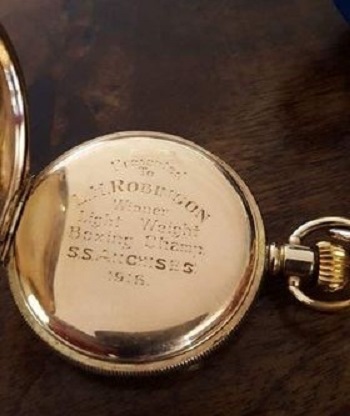
Gold Fob Watch presented to L.H.ROBINSON the Winner of the Light Weight Boxing Champion on board the S.S. ANCHISES 1916 during their voyage from Australia.
(Fob Watch: Ian Robinson:)
Leonard disembarked at Devonport England on the 11th October 1916. Leonard proceeded overseas for France on the 2nd of November from Southampton and was Taken on Strength with the 36th Battalion in the field on the 11th of November.
Leonard was Wounded in Action on the 7th of June 1917 at Messines, Belgium where he received a Gun Shot Wound to his left Leg and was evacuated to the 3rd Canadian General Hospital at BOULONE where his left leg was AMPUTATED below the knee.
7th June 1917.
THE BATTLE OF MESSINES
The 3rd Australian Divisions first major offensive was at Messines Ridge on the 7th June 1917. The Australian 3rd Division was a part of the II Anzac Corps which was allotted to the first assault. The 25th New Zealand, 3rd Australian Division with the 4th Australian Division in reserve. The 4th Division were battle hardened troops who had fought many major battles. The 3rd Australian Division were having problems getting to the "jump off" point. The day before the 9th and 10th Infantry Brigades were bombarded by German Gas-Shells around Hill 63 and Ploegsteert Wood. Many of the Aussies were not wearing gas masks, but despite this they pressed on even though they received 500 casualties.
They made it to the "jump off" point but only just with some of the men from the 9th and 10th going straight over the top without stopping. The mines went up and the attack commenced behind a protective barrage. The II Anzac Corps were attacking on the right with their objective being the southern shoulder of the ridge which included Messines, the Dover and St Yves areas as far south to the east of Ploegsteert Wood.
Major General Sir John MONASH's 3rd Division had to contend with a tricky 3 mile approach out of Ploegsteert Wood and after the German gas attack, but they were not deterred. The 9th Infantry Brigade under Brigadier General: Alexander JOBSON and the 10th Infantry Brigade under Brigadier General W R NICHOLL had just made the jumping off point but some of the men did not stop, going straight into the assault from the approach march.
Their objective lay between St Yves and the Douve. The mines at Trench 127 and Trench 12 at Factory Farm were laid to aid this task. The explosions erupted a few seconds before zero hour and created craters of 200 feet in diameter, completely obliterating the German defence line as the 9th and 10th Infantry Brigades went over the top. The mine crates forced the 9th and 10th Brigades to veer to the left and right which caused some confusion with the main assault. It is testimony to the quality of training that every man knew the ground, tasks and objectives so well.
Private: 1804 John CARROLL 33rd Battalion, rushed the enemy's trench and bayoneted four of the German occupants. He then noticed a comrade in difficulties and went to his assistance, killing another German. He then attacked single handed a German Machine Gun Team, killing all three of them and capturing the gun. He later rescued two of his comrades who had been buried alive by German Shell Fire, and in spite of heavy shelling and machine gun fire he dug them out alive and saved them from certain death. John was awarded the Victoria Cross.
The German forward zone was completely engulfed and taken by the main assault. The two supporting battalions of each brigade then passed the leading battalion to continue the advance. The men were constantly re-supplied and the ridge was taken. There were many German prisoners taken during the offensive. The 3rd Division was well ahead with the 9th Infantry Brigade pushing on beyond Grey Farm, and on the right the 10th Infantry Brigade were veering left towards Septieme Barn north of Douve.
The German resistance was heavy but was generally brushed aside by tanks and artillery before the infantry had to become too involved. The 4th Bavarian Divisions Artillery had made little impact, but as the day wore on the 3rd Division and later the 4th Australian Division received many casualties from German artillery. (70% of all casualties during WW1 were from artillery).
By 9:00am nearly 6 hours after the assault began the Germans were in disarray, but there was a major problem as the Australians received less casualties as anticipated and when ordered to dig into the ridge they had so many men, that some could not find shelter. the 35th battalion were dug in around Seaforth Farm.
The second phase of the operation was to take the Oosttaverne Line. The 3rd Australian Division would now be in reserve with the 4th Division attacking. The 9th Infantry Brigade (33-34-35-36Bn) were near Thatched Cottage facing Warneton. The river Lys was to their right and the Ploegsteert Wood was now behind them.
Once their objectives were taken the troops consolidated. A barrage to stop and counter attack was shortened and caught three battalions which had to retire. By 9:00 pm this part of the Oosttaverne Line was abandoned. At 10:45 pm General: Alexander John GODLEY ordered the 3rd and 4th Divisions to retake it. This they did by the early hours of the 8th of June.
The Battle for Messines Ridge during May-June 1917 saw 35 officers and 1,631 other ranks loose their lives.
9th Infantry Brigade Casualties.
| 33rd Battalion. AIF | 8 Officers | 382 Other ranks |
| 34th Battalion. AIF | 10 Officers | 378 Other ranks |
| 35th Battalion. AIF | 5 Officers | 431 Other ranks |
| 36th Battalion. AIF | 9 Officers | 421 Other ranks |
| 9th Machine Gun Company. AIF | 2 Officer | 17 Other ranks |
| 9th Light Trench Mortar Battery. | 1 Officer | 2 Other ranks |

FIELD DRESSING STATION, MESSINES 7th June 1917.
After Leonard's condition stabilised he was evacuated to England on board the Hospital Ship "St-David".
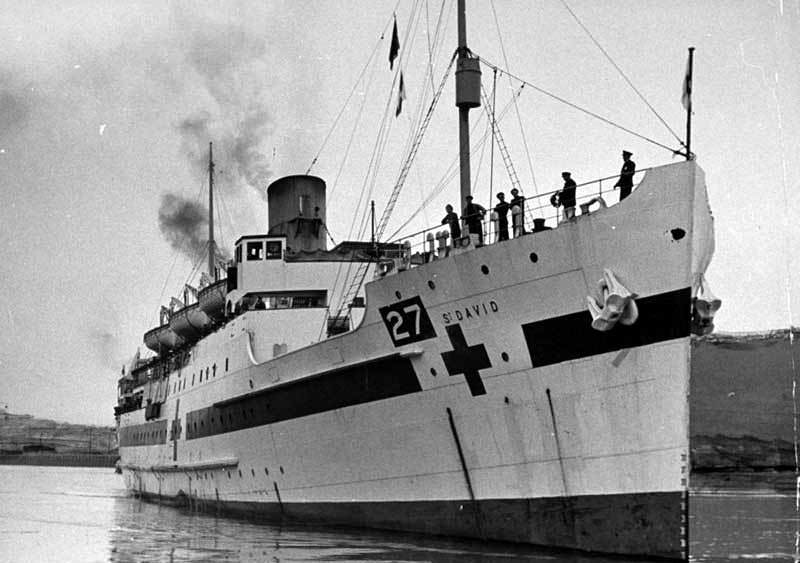

Leonard's British War Medal WW1:51994-Victory Medal WW1:50646 to PTE 2121 L.H.ROBINSON 36 BN and his British War Medal WW2:..-Victory Medal WW2:.. to N100869 CPL L.H.ROBINSON were auctioned in July 2007 in Queensland and are now in the Harrower Collection. Boxer who fought against Les Darcy in 1916 and was the Light Weight Boxing Champion on board HMAT A68 "Anchises" on their voyage from Australia in 1916. Leonard fought after the war as an amputee and was known as the Boxer with A Tin Leg. I sold to Leonard's medals to his Grandson Gregory Robinson in September 2022.
David Harrower ACM
Leonard served during World War 2 at the Recruitment Depot; service number: N100869 with the rank of Corporal and was discharged on the 31st of December 1942. Lived in Room 36 Narrabeen War Veterans Home.
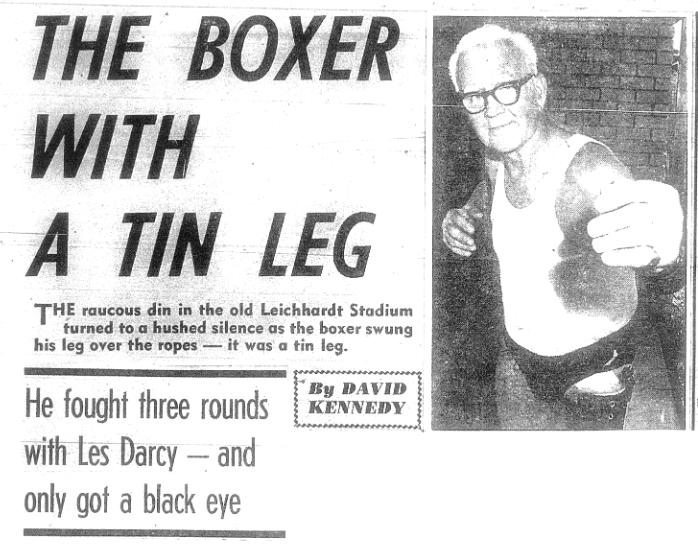

Leonard was a maternal Great Grandfather of mine, known to me as Granddad Robinson. I recall visiting him and his later wife Florence at the Narrabeen War Veterans Homes when I was a child in the 1970’s. My brothers and I were amazed by his tin leg and loved to tap on it. We once went swimming with Leonard at Dee Why beach. He would take his tin leg off and leave it by the shore line when he went body surfing. This day the tide was rising and a wave washed it out into the water. My Dad had to swim out to get it.
He never spoke to his family of his war service and it was only that I started researching about 15 years ago that we discovered his service details, being wounded on the opening day of the Battle of Messines. He was close to his son-in-law, my grandfather, Eric LUSK a WWII RAAF Navigator, who told me that Leonard never let his war experiences take away his industrious, numerous and cheeky nature his whole life. I recall him as a happy and cheeky older man who could hand build some excellent models from matches and other things. However, my mum, his grand daughter, recalls when staying with Leonard as a child that he did have trouble sleeping and would wake yelling and diving to the floor from his bed. Leonard's wife, Adela, suffered mentally from middle age until her death. It is unclear the source of her mental distress – she did serve as a nurses in England during WWI however my mother suspects she suffered living with Leonard's late night despair and anxiety.

Adela May Robinson. nee: Couzens. (1898-1961)
(Brendon Wood November 2018)

2121 Private L.H.ROBINSON 36 BATTALION 27-7-1977 AGE 84. Sydney War Cemetery Memorial Avenue ROOKWOOD, NSW. 2141. Australia. Area: Wall: 4 Row: Panel: E
7th September 2022
Collected medals from Display at Swansea RSL to be cleaned and re mounted as I have sold them to Greg Robinson the Grandson of Leonard. Glad that they have be re united with his family.
David Harrower ACM

















Under Construction; 23/06/2007-30/08/2022.
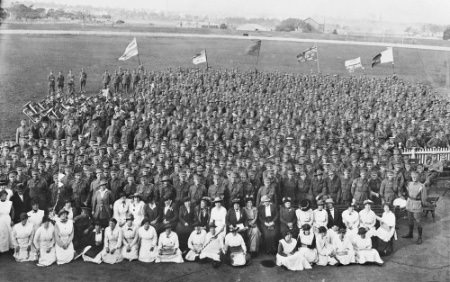
Born: 19th January 1889. Birkenhead, England.
Father: William Prescott. (1863-1915)
Mother: Sarah Elizabeth Prescott. nee: Headen. (1868-19..)
After training in England he embarked for France via Southampton on 22nd of November 1916 and was Taken on in Strength with the 36th Battalion in the field and was Wounded in action; 1st occasion on the 16th of January 1917 when he received Gun Shot Wounds to his Left Side and Left Armand was treated by the 9th Australian field Ambulance and evacuated to the 8th Casualty Clearing Station. Andrew was treated for his injuries and rejoined his unit on the 21st of January 1917. He remained in and out of the front line and in June 1917 saw action in the 1st Battle of MESSINES.
The 3rd Australian Divisions first major offensive was at Messines Ridge on the 7th June 1917. The Australian 3rd Division was a part of the II Anzac Corps which was allotted to the first assault. The 25th New Zealand, 3rd Australian Division with the 4th Australian Division in reserve. The 4th Division were battle hardened troops who had fought many major battles.The 3rd Australian Division were having problems getting to the "jump off" point. The day before the 9th and 10th Infantry Brigades were bombarded by German Gas-Shells around Hill 63 and Ploegsteert Wood. Many of the Aussies were not wearing gas masks, but despite this they pressed on even though they received 500 casualties.
They made it to the "jump off" point but only just with some of the men from the 9th and 10th going straight over the top without stopping. The mines went up and the attack commenced behind a protective barrage. The II Anzac Corps were attacking on the right with their objective being the southern shoulder of the ridge which included Messines, the Dover and St Yves areas as far south to the east of Ploegsteert Wood.
Major General Sir: John MONASH's 3rd Division had to contend with a tricky 3 mile approach out of Ploegsteert Wood and after the German gas attack, but they were not deterred. The 9th Infantry Brigade under Brigadier General Alexander JOBSON and the 10th Infantry Brigade under Brigadier General W R NICHOLL had just made the jumping off point but some of the men did not stop, going straight into the assault from the approach march.
Their objective lay between St Yves and the Douve. The mines at Trench 127 and Trench 12 at Factory Farm were laid to aid this task. The explosions erupted a few seconds before zero hour and created craters of 200 feet in diameter, completely obliterating the German defense line as the 9th and 10th Infantry Brigades went over the top. The mine crates forced the 9th and 10th Brigades to veer to the left and right which caused some confusion with the main assault. It is testimony to the quality of training that every man knew the ground, tasks and objectives so well.
Private: 1804 John Carroll 33rd Battalion, rushed the enemy's trench and bayoneted four of the German occupants. He then noticed a comrade in difficulties and went to his assistance, killing another German. He then attacked single handed a German Machine Gun Team, killing all three of them and capturing the gun. He later rescued two of his comrades who had been buried alive by German Shell Fire, and in spite of heavy shelling and machine gun fire he dug them out alive and saved them from certain death. John was awarded the Victoria Cross.
The German forward zone was completely engulfed and taken by the main assault. The two supporting battalions of each brigade then passed the leading battalion to continue the advance. The men were constantly re-supplied and the ridge was taken. There were many German prisoners taken during the offensive. The 3rd Division was well ahead with the 9th Infantry Brigade pushing on beyond Grey Farm, and on the right the 10th Infantry Brigade were veering left towards Septieme Barn north of Douve.
The German resistance was heavy but was generally brushed aside by tanks and artillery before the infantry had to become too involved.The 4th Bavarian Divisions Artillery had made little impact, but as the day wore on the 3rd Division and later the 4th Australian Division received many casualties from German artillery. (70% of all casualties during WW1 were from artillery).
By 9:00 am nearly 6 hours after the assault began the Germans were in disarray, but there was a major problem as the Australians received less casualties as anticipated and when ordered to dig into the ridge they had so many men, that some could not find shelter. the 35th battalion were dug in around Seaforth Farm.
The second phase of the operation was to take the Oosttaverne Line. The 3rd Australian Division would now be in reserve with the 4th Division attacking. The 9th Infantry Brigade (33-34-35-36Bn) were near Thatched Cottage facing Warneton. The river Lys was to their right and the Ploegsteert Wood was now behind them.
Once their objectives were taken the troops consolidated. A barrage to stop and counter attack was shortened and caught three battalions which had to retire. By 9:00 pm this part of the Oosttaverne Line was abandoned. At 10:45 pm General Alexander GODLEY ordered the 3rd and 4th Divisions to retake it. This they did by the early hours of the 8th of June.
The Battle for Messines Ridge during May-June 1917 saw 35 officers and 1,631 other ranks loose their lives.
| 33rd Battalion. AIF | 8 Officers | 382 Other ranks |
| 34th Battalion. AIF | 10 Officers | 378 Other ranks |
| 35th Battalion. AIF | 5 Officers | 431 Other ranks |
| 36th Battalion. AIF | 9 Officers | 421 Other ranks |
| 9th Machine Gun Company. AIF | 2 Officer | 17 Other ranks |
| 9th Light Trench Mortar Battery. | 1 Officer | 2 Other ranks |
Andrew survived the first day of fighting but was Wounded in Action; 2nd occasion on the 8th of June 1917 when he received a Gun Shot Wounds to his Right Leg and was again evacuated to the Casualty Clearing Station for treatment. Andrew was transferred to the 5th Southern General Hospital on the 13th of June. Andrew was granted furlo back in England at Perham Downs from the 20th of July until the 3rd of August 1917 but failed to report and was Charged Absent Without Leave from 3:30 pm 3rd August Until noon 4th August 1917 and was ordered to forfeit 3 days pay and was confined to camp by Lieutenant Colonel: CRAMPTON.
Andrew returned to France via Southampton on the 5th of September and was marched to Roulles and rejoined his unit on the 7th of September. The 36th with the 9th Infantry Brigade were preparing for the battle of Passchendaele on the 12th of October where Andrew was Wounded in Action; 3rd occasion
12th October 1917
THE BATTLE OF PASSCHENDAELE I
At 1:30 am rain showers began. By 2:30 am it was raining lightly but steadily, by 3:30 fairly heavily. the infantry moved through the pitch dark in single file. In some battalions each man held on to the equipment of the man ahead of him; if touch was broken, those in front had to come back. The news that the line as reported by the 66th division was not held only just reached the incoming troops. Accordingly, in the right brigade (9th) the leading Company Commanders Captain: Clarence Smith JEFFRIES. V.C. and Captain: Telford Graham GILDER M.C. both of the 34th Battalion stopped their men at the entrance to Broodseinde railway cutting, and themselves went to make sure that their column might not run into the enemy.
At Keerselaarhoek Cemetery they found the tape duly laid, and met the officer of the 36th Battalion who had laid it, and by 3:00 am the time set, the 34th battalion was extended on its jumping-off position. But during the previous halt and afterwards, as it lay on the tape, the battalion was persistently shelled and suffered many casualties.
The first shell killed three signallers. Lieutenant: Albert Leslie WATSON. a signal officer of the 34th Battalion, a brave and enterprising leader who also was at the head of the column was severely wounded and all his staff hit. After establishing a forward command post Lieutenant: Thomas Fraser BRUCE 36th Battalion was also killed. Lieutenant Colonel: John Alexander MILNE. 36th Battalion supervising the assembly was knocked down by a shell but continued to command. Captain, Chaplain: Charles MURPHY was also wounded.
(BEAN; History of World war 1 Vol IV p911) Charles Edwin Woodrow BEAN
Only one Australian Division, the 3rd, was wholly employed in the days offensive. but the division was to capture Passchendaele an in spite of the depressing conditions, it was eager to achieve the distinction of doing so. One unit carried the Australian flag,to be planted in Passchendaele, and although officers and men in general were not enthusiastic concerning such "stunts" the Commander-in-Chief had been informed, and had told General: MONASH that, when this flag was planted, the news would be immediately cabled to Australia.
Some keen spirits looked on the operation simply as a dash for Passchendaele. One young company commander of Monash's reserve battalion, the 33rd, in face of a strict prohibition, led on his company as soon as the barrage fell. Starting from a line 350 yards in rear of the general alignment, the 3rd Division was out of touch with its neighbours from the outset. The heavy shelling on the tapes had made orderly disposition there almost impossible, as German Machine-Guns, undisturbed by the barrage now opened immediately, no opportunity offered of restoring proper formation.
The 9th Brigade went forward in the utmost confusion and a terrible mix up as reported by Captain: Robert Derwent DIXON D.S.O 35th Battalion at 6:40 am and "Great Confusion" was the description given by Captain: Henry Vince CARR 35th Battalion. Even on the ridge, the mud was difficult, the hope, if there ever was one, of catching up before the quick barrage finished.
The 9th Infantry Brigade's intendered direction lay not along the ridge and the Passchendeale road, but diagonally across them, and parallel to the railway, which most of the brigade could not see. As the jumping-off line was practically at right angles to the ridge, the brigade tendered to advance alone the heights. The Machine-Gun fire at the start came, on the 9th Brigade's right, from the ruined house near Defy Crossing; on its centre from, "Hillside Farm"; and on its left from Augustus Wood.
The pillbox opposite the centre was supported from the rear by a trench in which were Germans with Machine-Guns, and here occurred a delay which threatened to wreck to whole attack. it was not until an hour after the programme time that these places were rushed by the neighbouring portion of the line under Captain: Henry Vince CARR and Captain: Robert Derwent DIXON. D.S.O of the 35th Battalion. The trench contained 35 Germans and 4 Machine-Guns. Part of the line was also held up by a pillbox close to Passchendaele road near the highest point of the ridge.
Here there was practically no shelter from attack, but Captain Clarence Smith JEFFRIES. V.C. of the 34th Battalion managed to organise a party, with Sergeant: 21 James BRUCE and another N.C.O Corporal: 2036 Vere Cummings STEVENSON and a dozen men, and outflanking it, charged the place from the rear, capturing 25 Germans and 2 Machine-Guns. These actions set free the advance. The pillbox captured by Captain Clarence Smith JEFFRIES. V.C. being not far short of the first objective, the 34th Battalion dug in there.
Great loss had been uncured; the 34th Battalion had only three officers left and there were wide gaps in the line. The right flank had swung far away from the railway, along which the 4th Division was attacking, but on the left Captain: Telford Graham GILDER M.C. of the 34th Battalion who had been wounded by a Machine-Gun bullet, but was carrying on found the 10th Brigade digging in slightly to his left under Captain: LATCHFORD, 38th Battalion, and fell back seventy yards to join it.
The Advance to the second objective was to begin at 8:25, the low clouds had opened, and fleecy cirrus with patches of blue were widening overhead and the sun had come out. The 9th Brigade had been so late in reaching the first objective that, while most of the 34th Battalion dug in, the 35th Battalion, allotted for the second phase, moved straight on. Standing on the Passchendaele road, Captain: Henry Vince CARR and Captain: Robert Derwent DIXON. D.S.O of the 35th Battalion endevoured to decide where the barrage then was; at first Carr thought it may be behind them, but finally decided that it was ahead.
The confusion at the start had split the brigade into mixed parties of all battalions and many of the 34th went on with the 35th, the main body of which, about 100 in all, now advanced along the south-eastern side of the ridge in order to catch the barrage. The hour was probably a little before that for the second advance. A German Machine-Gun in the gap between the brigade's right and the railway immediately opened with deadly effect.
Major: John Bruce BUCHANAN 36th Battalion, the senior forward officer was killed. At this critical juncture Captain: Clarence Smith JEFFRIES. V.C. of the 34th Battalion, again accompanied by Sergeant: 21 James BRUCE, led out a few men from the first objective and made for the gun. it was shooting in short bursts, and he was able to work up fairly close. Seizing a moment when it was firing to the north, he and his men rushed at it from the west. It was switched round, killing him, and sending his men to the ground.
But when its fire eased they worked round it, rushed the position, seized 25 Germans and 2 Machine-Guns. This gallant and effective action Captain: Clarence Smith JEFFRIES. V.C. was posthumously awarded the Victoria Cross for removing the chief danger to the advance along the crest, but as soon as the 35th Battalion crossed to the eastern side of the hill it became the target of a number of field and heavy guns which, from the hedges and other cover in various parts of the landscape, fired over open sights.
After passing a corpse on its right, the 35th Battalion settled down on what its officers took to be the second objective, although on the extreme right they were actually short of the first. Captain: Henry Vince CARR, now the senior officer on the spot, reported; 8:35. On objective, with about 100 Captain: Robert Derwent DIXON. DSO and three officers. Casualties 25 or 30 per cent. Captain: Henry Charles Dight CADELL M.C Lieutenant: Charles Teesdale MAIN Lieutenant: Keith Maitland DAY reported killed and Lieutenant: Frank HORNE Lieutenant: Christopher Kyffin MEARS Lieutenant: Charles John HENRY were wounded. Prisoners sent back 400-500. Contact on flanks uncertain, being heavily shelled.
Three posts were established under surviving officers, right Lieutenant: Norman Beade D'ARCY M.C centre Lieutenant: Joseph Francis ADAMS left Lieutenant: Harold Sydney WYNDHAM. In this brigade the battalion for the final objective was the 36th, and a report came along that it had gone through. Actually, it had advanced with the 35th, but, on the left, penetrated to the second objective, which bad been reconnoitered during the previous halt by the commander of the company Captain Robert Austin GOLDRICK. M.C.
He went up the road towards Passchendaele. The barrage, he said afterwards was no hindrance to him, although he left the line lying as close to it as possible "or where he thought it was." He was unable to detect the intensification of the barrage for the second phase, but led his men forward at the proper hour.
As no other battalion was there, he now established the line with its left on the road 600 yards from the church, about the point reached by the 66th Division's troops on October 9th. In front of the position Captain: Robert Austin GOLDRICK. M.C. and Lieutenant E.H FLEITER (39th Battalion) found hidden in a shell hole men of the 66th Division. One had a broken arm, the other trench-feet. They took the Australians at first for Germans. When reassured,"we knew the Australians would come," they said, 'We prayed hard."
From the direction of the church, which lay straight down the highway, no fire came. two Germans ran up the road and surrendered. South-east of the village, along the Moorslede road, were the Germans who seemed "very windy," and near the road two 5.9-inch howitzers began to blaze at the troops digging in.
The 9th Brigade had taken its second objective and the 10th its first, but the position of the officers in charge of these advanced lines was full of anxiety. On the eastern slope Captain: Henry Vince CARR 35th Battalion, the senior officer in this part of the 9th Brigade's front, could see the 4th Division somewhat ahead of its right, and by 10:55 he had discovered that the 36th was on the left, but farther left than the 10th Brigade was far behind on its first objective . The German Guns ahead were sniping with dreadful accuracy. Carr on the western slope, sent back for instructions: "what am I to do?"
Word of the true situation reached headquarters slowly. As on the 9th, the first news was all encouraging. General: MONASH in the Ypres ramparts heard shortly after 7 that both brigades were "well away"; but by 8:26 he had ample evidence that the first objective was taken. At 9:25 the intelligence officer examining prisoners (Lieutenant: Frederick Morley CUTLACK Official War Correspondent) reported having heard from the wounded men that the second objective had been reached.
At 10:28 headquarters was informed of a statement of a wounded man, that the 38th Battalion had gone through. A further report that Australians had been seen at Crest Farm although quickly contradicting but probably true nevertheless. Which confirmed Monash's impression that his division was succeeding. Concerning the New Zealand brigade on his left, however, there was no word until, at 10:50, there arrived the tragic information that the New Zealand Division was stopped by the enemy alone the entire front.
Monash has already heard at 9:55 that the 10th Brigade was held up by fire from Bellevue Spur. Believing that his division was still advancing, he asked that every gun that the New Zealand Division could spare should be turned upon that ridge to suppress the fire. Meanwhile, he would order the reserve (39th) battalion of the 10th Brigade to be ready to assist in holding the ground already won. The reserve battalion the (33rd) of the 9th Brigade he was still keeping back to assist in the capture of Passchendaele.
Shortly after noon news of the true situation arrived. Lieutenant Jackson of the 40th Battalion had established at Waterfields pillbox near the Ravebeek a forward report-centre from which a series of messages, admirably accurate, was flashed by lamp to the headquarters of Lieutenant Colonel Lord of the 40th Battalion. Thus Brigadier General McNicoll of the 10th Brigade was able to inform Monash of the precise position of Giblin's Line. He added that the situation was very serious and the casualties very heave. At the same time from the front line of the 9th Brigade arrived a pigeon message, sent by Captain: Richard GADD of the 36th Battalion.
We are on the Blue Line (second objective) with composite force all three battalions, both flanks in the air.
The New Zealand Division was to make a second attempt at 3:00 pm, and Monash was of the opinion that from the 9th Brigade, well forward on the ridge, patrols might still work northward around Crest Farm. His reserve, the 33rd Battalion (9th Brigade), was accordingly ordered to attempt this at 4:30 pm and the 10th Brigade's forward line being meanwhile reinforced by its own reserve, the 39th Battalion.
These orders went out, but none of them were fulfilled. The New Zealand Division had been defeated by obstacles which no hastily renewed bombardment could have overcome. no infantry in the world could have crossed the Ravebeek mud, penetrated the dense wire, and attacked the crowded pillboxes of Bellview with the assistance of a barrage which did not even screen the advance. No blame can attach to the artillery. Its commander, according to the New Zealand official history, had reported on the previous day that his guns might be unable to give efficient support.
This magnificent division, which lost nearly 3,000 men, had been held up in almost exactly the same position as the 49th three days before-the left brigade penetrating half-way to the first objective, the right stopped almost at the start.The Germans were reinforcing. The New Zealand battalion commanders knew that their men had no chance of succeeding by renewed attack, and the order was eventually cancelled.
As for the Australians, of the two battalions that MONASH had now ordered to participate, the 39th had already to a large extent been involved in the fighting, and the 33rd, endevouring to reach its position of readiness for outflanking Passchendaele,had suffered great loss. No less than 6 of its Officers were killed or mortally wounded. Captain: Wilfred Frank HINTON in command of the forward company, Lieutenant Leonard Rockley BROWNLOW Lieutenant: Thomas Acheson ARMSTRONG Lieutenant: Albert George KILPATRICK Lieutenant William REES-REYNOLDS and Lieutenant: Norman Francis GOBLE.
By the time Lieutenant Colonels Henderson DSO 39th Battalion and MORSHEAD attempted to carry Monash's orders, they found that the attacking force of both brigades was back almost at its starting point. What had happened was as follows.
Neither Major: GIBLIN near the Ravenbeek nor Captain: Henry Vince CARR on the ridge had received their messages sent several hours earlier. The 9th Brigade's line was still being battered by the German Guns. Captain: Richard GADD 36th Battalion, whose troops were being wiped out, informed Captain: Henry Vince CARR 35th Battalion that Lieutenant Colonel: John Alexander MILNE D.S.O 36th Battalion had now come forward to Hillside Farm. CARR accordingly sent Captain: Robert Derwent DIXON. D.S.O with GADD to explain to Milne the desperate nature of their situation. Milne said that he would try to get their troops relieved after dark, but till relieved they must hold on.
(BEAN; History of Word War 1 Vol IV page 921) Charles Edwin Woodrow BEAN
Meanwhile, however, the German artillery was annihilating some parts of their line. All leaders of Carr's three posts were out of action. Lieutenant: Joseph Francis ADAMS was Killed in Action and Lieutenant: Norman Beade D'ARCY M.C and Lieutenant: Harold Sydney WYNDHAM were wounded. Of the remaining officers of the 36th Battalion, Major: John Bruce BUCHANAN and Lieutenant: Fredrick William PUTNEY had been Killed in Action and Captain: Robert Austin GOLDRICK M.C wounded. Farther back Lieutenant: Sydney COOK had been Killed in Action and Lieutenant: William WAND and Lieutenant: Herbert Reginald MAILER were wounded.
At 3 o'clock rain began to fall steadily. at 3:15 pm Captain: Richard GADD 36th Battalion, thought agreeing with Captain: Henry Vince CARR 35th Battalion that to hold on meant annihilation, refused, in view of his Colonel's orders, to retire. Carr consented to wait while Gadd again sent word to Lieutenant Colonel: John Alexander MILNE D.S.O. Carr himself at 12: 30 had sent Captain Robert Derwent DIXON. D.S.O to the headquarters of the 35th Battalion at " Seine", from which no word had been received all day.
At 3:45 pm, no reply having come from Milne, and Dixon not having returned as he had been kept at 35th Battalion headquarters awaiting the arrival of an order from brigade headquarters concerning the projected operation by the reserve battalion, Gadd agreed to withdraw and Carr sent along the line a note: The 35th Battalion will retire.
When visiting Gadd, Carr had warned the troops of the probable order to withdraw, and he now saw that the left had already begun to retire. He told men whom he passed to get back as fast as they could to the 34th Battalion (which he believed to be on the first objective). Captain: William James GORDON M.C 36th Battalion, strongly dissatisfied with the order, went straight to Lieutenant Colonel: John Alexander MILNE D.S.O urged that the forward position was tenable, and with Milne and Major: John Martin HAWKEY M.C rushed out to stop the withdrawal. But it was too late.
The 34th was not, as Captain: Henry Vince Carr 35th Battalion, believed, on the first objective. The Commander of the line, Captain: John William RICHARDSON 34th Battalion, on hearing of the extreme weakness of the force at the second objective, had reinforced it. He and his only remaining officer's Lieutenant: James Clement BURGES Lieutenant: Bruce Gray McKENZIE Lieutenant: John Abbott LONGWORTH had all been Killed in Action while organising on the first objective, and the first objective now lay empty. The retiring troops, being without orders as to the position to be taken up, streamed back past Milne's headquarters.
All that Hawkey, Gordon, Gadd, and others could then do was to lead a fraction of them forward again to the first objective, where they remained during the night. Captain: Robert Derwent DIXON. D.S.O. with Captain: John Grieve PATERSON adjutant of the 35th, went up to organise the 35th there, but could find none of it's men. When eventually re-formed the remnant of the 35th was temporarily attached as a Company to the 33rd Battalion.
9th-12th October 1917 saw the 3rd Division, 9th and 10th Infantry Brigade in action during the Battle of Passchendaele, which saw massive losses and suffering in the Australian ranks. The casualties numbered 3,199 men in 24 hours during the height battle. The 34th Battalion lost every officer that day, either killed or wounded including their Medical Officer, Major: Gother Robert Carlisle CLARKE and some of his staff were killed while dressing the wounded. The spirit of some of the wounded is illustrated by the case of Corporal: 3170 Winsleigh Alexander MURRAY 35th Battalion, (formerly a Methodist Minister from Newcastle) gave up his place in a queue waiting for stretcher bearers and was never heard of again.
The Battle of Passchendaele saw 60 Officers and 1,322 other ranks loose their lives.
9th Infantry Brigade Casualties.
| 33rd Battalion. AIF | 11 Officers | 273 Other ranks |
| 34th Battalion. AIF | 15 Officers | 323 Other ranks |
| 35th Battalion. AIF | 18 Officers | 296 Other ranks |
| 36th Battalion. AIF | 15 Officers | 383 Other ranks |
| 9th Machine Gun Company. AIF | 1 Officer | 36 Other ranks |
| 9th Light Trench Mortar Battery. | - Officer | 11 Other ranks |
Andrew received a Severe Gun Shot Wound to the Head during this major offensive by the 9th Infantry Brigade and he was treated by stretcher bearers from the 9th Australian Field Ambulance before being evacuated to the Casualty Clearing Station and back to England on board the Hospital Ship "Pieter de Connick" on the 29th of October where he was then transferred to the Norfolk and Norwich War Hospital.
After Andrew recovered from his Head injuries he was granted a furlo from the 7th of January until the 21st of January 1918 but again he failed to report and was again Charged Absent Without Leave from 21st of January until the 19th of February 1918 and was ordered to forfeit 28 days pay by Major C H HOWARD. Whilst Andrew was absent he was awarded the Military Medal.
8th February 1918.
Commonwealth of Australia Gazette 27th of June 1918. Page 1393 Position 184.
Andrew returned to Australia 1st of June 1918 on board HMAT A30 "Borda" and was discharged Medically Unfit on the 30th of November 1918.
I found your site while researching my family history, specifically my great uncle Andrew Prescott. He joined B company of the 36th Battalion on 28th February 1916. His number was 542, and he won a military medal in 1918. I found this information in the Australian Archives, after following up information given to me by other family members. I would like to congratulate you on your site. I think it is a fitting tribute to the sacrifice given by so many people.
He was awarded the Military Medal and when members of the family asked him, he said he won it rescuing an American Officer under fire. He told my uncle that he gave away his medals to a boy in Newcastle NSW after the war. During his active service he was wounded on three separate occasions, and after the war was invalided out of the army as a result of his wounds on 30/11/1918
He returned to England and was subsequently a seaman in the merchant navy. His wounds always troubled him and he was told not to take baths. He ignored this and when he had a bath my grandmother would on occasion find small pieces of shrapnel after he had gotten out.
(Great Nephew; Ian Phillips of Merseyside, United Kingdom. May 2009)






















UNDER CONSTRUCTION; 29/04/2009-26/12/2013.

Born: 1891. Merewether, Newcastle, New South Wales. Birth Cert:21872/1891.
Died: 13th October 1926. Randwick via Sydney, New South Wales, Australia. Death Cert:18090/1926.
Father: John Thomas Spark. (1863-1917)
Mother: Ellen Jane Spark. nee: Edwards. (1867-1926)

Herbert returned to his battalion and was Wounded in Action on the 30th of May 1917 and treated at the 9th Australian Field Ambulance before returning to duty.
Herbert returned to Australia on the 11th of May 1919 on board HMAT A30 "Borda".

Postcard sent home from Salisbury Plains, England


Sandgate Cemetery Newcastle, New South Wales, Australia.
Military Records













Under Construction: 20/11/2006-13/09/2019.

Born: 23rd May 1893. Adamstown, New South Wales, Australia. Birth Cert:3444/1893.
Married: 1915, Hamilton via, Newcastle, New South Wales, Australia. Marriage Cert:1523/1915.
Wife: Florence Lillian Crook. nee: Barrett. (18..-1951)
Died: November 1954. Newcastle, New South Wales, Australia.
Buried: 2nd December 1954. Newcastle, New South Wales, Australia.
Father: John "Jack" Crook.
Mother: Ellen Crook. nee: Pain.
64 years ago today, on the 2nd December 1954, Private Daniel Crook, 35th Battalion, labourer of Hampden Avenue, Adamstown, New South Wales and 52 Mackie Avenue, New Lambton, N.S.W., was laid to rest at Sandgate Cemetery, age 61.
http://nla.gov.au/nla.news-article134089802
Born at Adamstown, New South Wales on the 23rd May 1893 to Jack (John) and Ellen Crook; husband of Florence Lillian Crook nee Barrett (married 1915, died 1951), Daniel enlisted December 1915 at Newcastle, N.S.W., and returned home June 1919.
http://nla.gov.au/nla.news-article137105449
http://nla.gov.au/nla.news-article139435381
http://nla.gov.au/nla.news-article162571788
His name has been inscribed on the Adamstown Citizens' Memorial (photo) and the Adamstown Methodist Church Honour Roll (http://nla.gov.au/nla.news-article134867979).

Younger brother Cecil James Crook, born 1899, Reg No-4562, died of wounds 4.10.1918 (photo).
A wooden cross had been erected by the owner of the grave some time ago, the inscription almost unreadable, so I have placed a cross adorned with poppies on the gravesite, taken a photo of the grave and uploaded the photo onto the Northern Cemetery website as a permanent record of his service.

Sandgate Cemetery
http://sandgate.northerncemeteries.com.au/…/war-…/index.php…
Photo of the Adamstown Citizens' Memorial (Panel 3) taken by Ken Shilling, available from “Remembrance” CD, at the Newcastle Family History Society.
Lest We Forget.
(Gary Mitchell: December 2018)
His portrait and mother badge are in the possession on the Australian War Memorial in Canberra, Australian Capital Territory.

Mothers Badge 2 Bar (both Ellen's son's died during the Great War)











Under Construction 01/2005-02/12/2018.
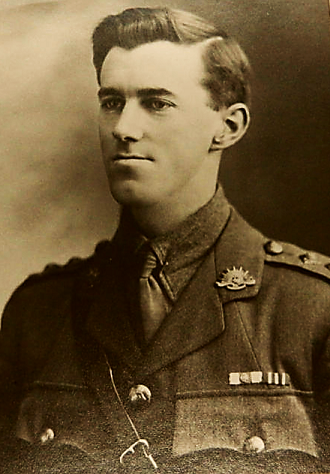
Born: 9th October 1894. Yawkecarba, Stroud, New South Wales, Australia. Birth Cert:32434/1894.
Married: 22nd April 1933. Wingham, New South Wales, Australia. Marriage Cert:7834/1933.
Wife: Violet Rachel Dun. nee: Andrews. (1902-1982)
Died: 12th October 1971. Grafton, New South Wales, Australia. Death Cert:67574/1971.
Father: Thomas Dun. (1846-1899)
Mother: Elizabeth Bulter Dun. nee: Miles. (1855-1929)
After resuming duty on 8 November Dun was commissioned second lieutenant and transferred to the 38th Battalion; he was serving with this unit when he won the Military Cross for gallantry in a raid on enemy trenches. The citation stated that he had 'led his men with great dash and determination, killing the crew of a machine gun and capturing the gun'. On 2 April 1918 he was promoted lieutenant and transferred back to the 35th Battalion. He served at Villers-Bretonneux in April, at Morlancourt in May and in the battle of Amiens in August. Though wounded on 8 August he remained on duty. Three weeks later, during the Battalion's attack on Curlu, he 'led his men splendidly through dense fog and on two occasions headed a charge against machine guns, capturing the guns and some forty prisoners'. His 'determined courage cheered his men and was largely instrumental in getting them forward'. Of this action a battalion sergeant stated: 'Lieutenant Dun really deserved the V.C.; his men would follow him anywhere'. He was awarded a Bar to his Military Cross but he had been wounded, for the fourth time, at Curlu and saw no further active service. In addition to his three decorations he was mentioned in dispatches.
Dun returned to Australia in June 1919 and his A.I.F. appointment ended on 28 July. After demobilization he worked in a sawmill at Glenreagh, New South Wales, and, by the time of his marriage to Violet Rachel Andrews on 22 April 1933, was the mill's accountant. He ultimately became manager, and retired in 1960. While employed at the sawmill he built up a grazing property in the district and continued to work it until his death. Survived by his wife, a son and a daughter, he died at Grafton of heart disease on 12 October 1971 and was buried in Clarence lawn cemetery, South Grafton.
M. E. Lyne, Newcastle's Own: The Story of the 35th Battalion, A.I.F. (Newcastle, nd); E. Fairey, The 38th Battalion, A.I.F. (Bendigo, 1929); C. E. W. Bean, The Australian Imperial Force in France, 1917-18 (Syd, 1933, 1937, 1942); London Gazette, 14 Aug 1917, 13 May, 7 Nov 1918; private information
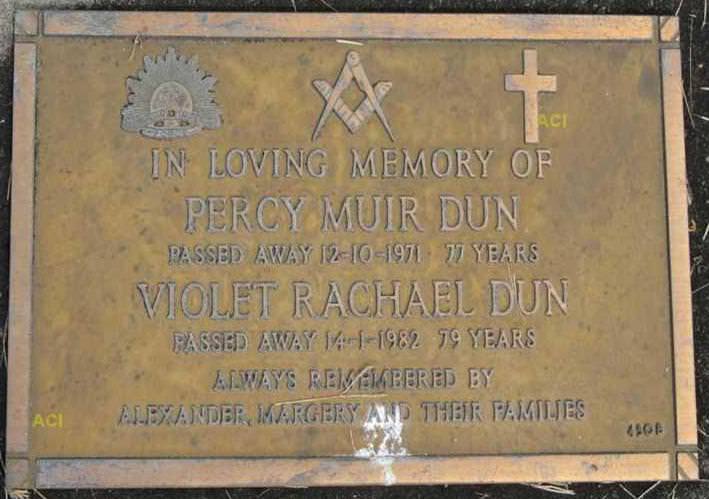
(Photo; Richard Clay; December 2019)
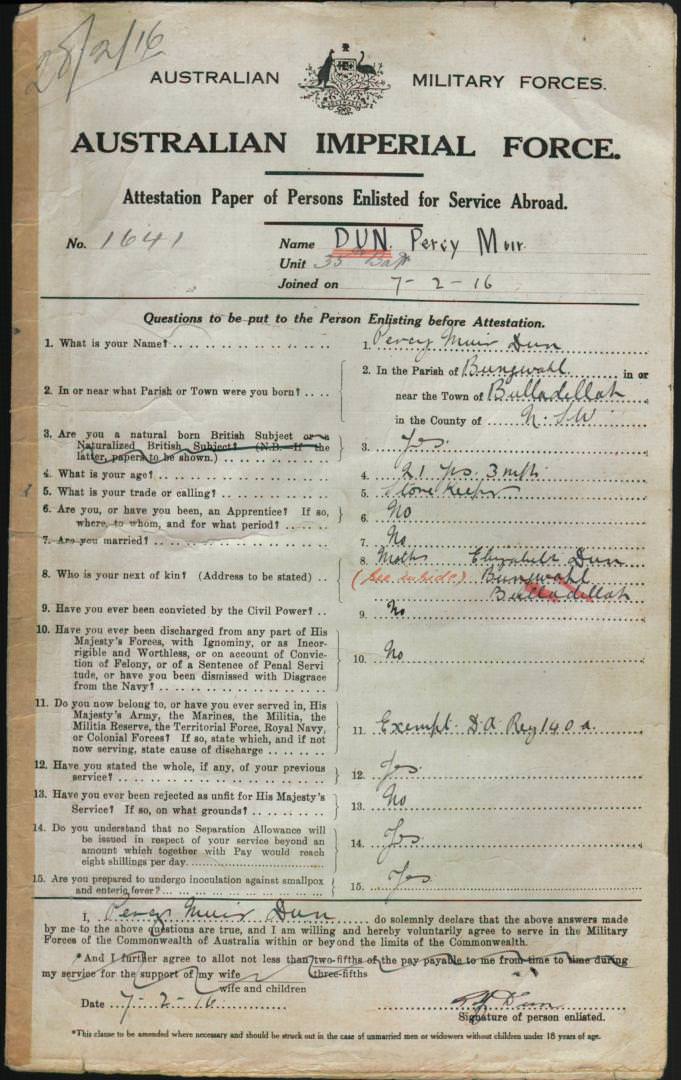
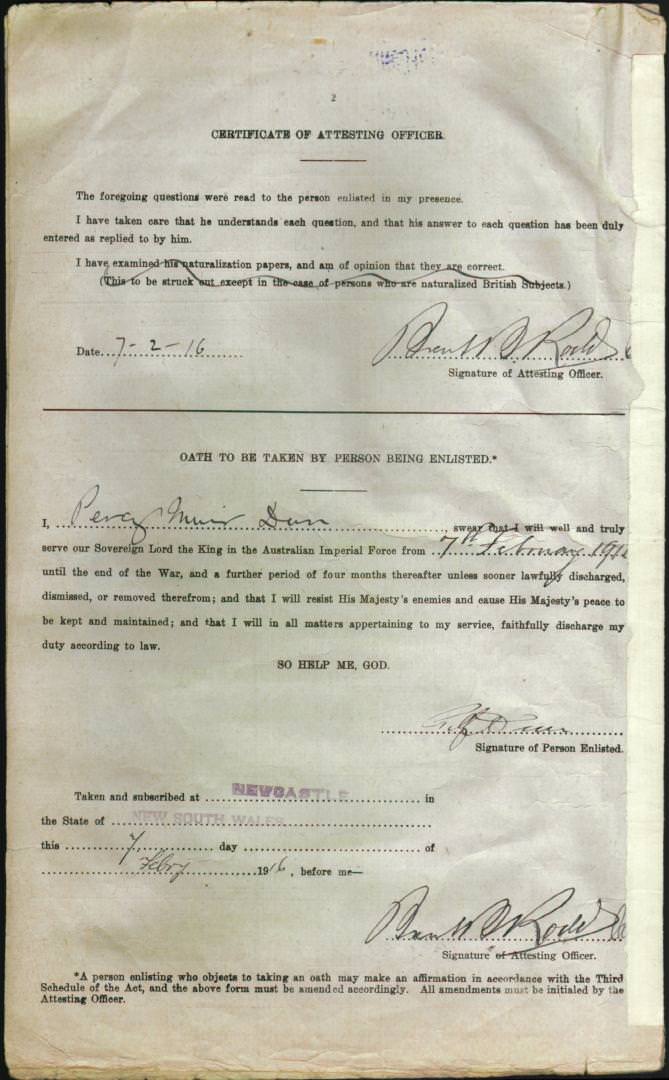
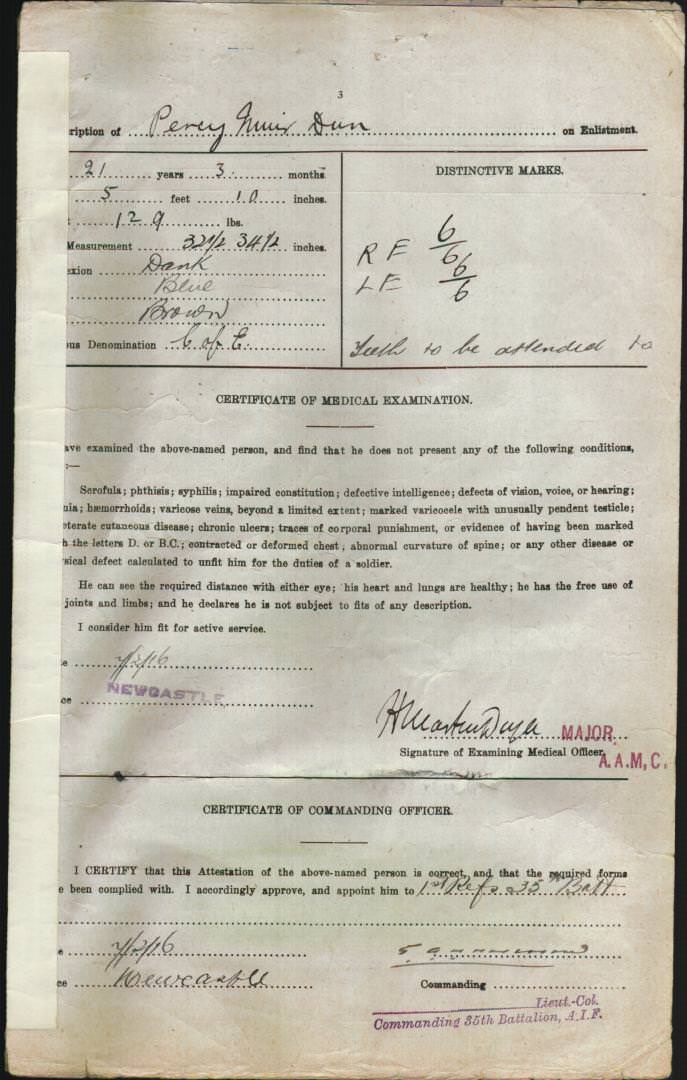
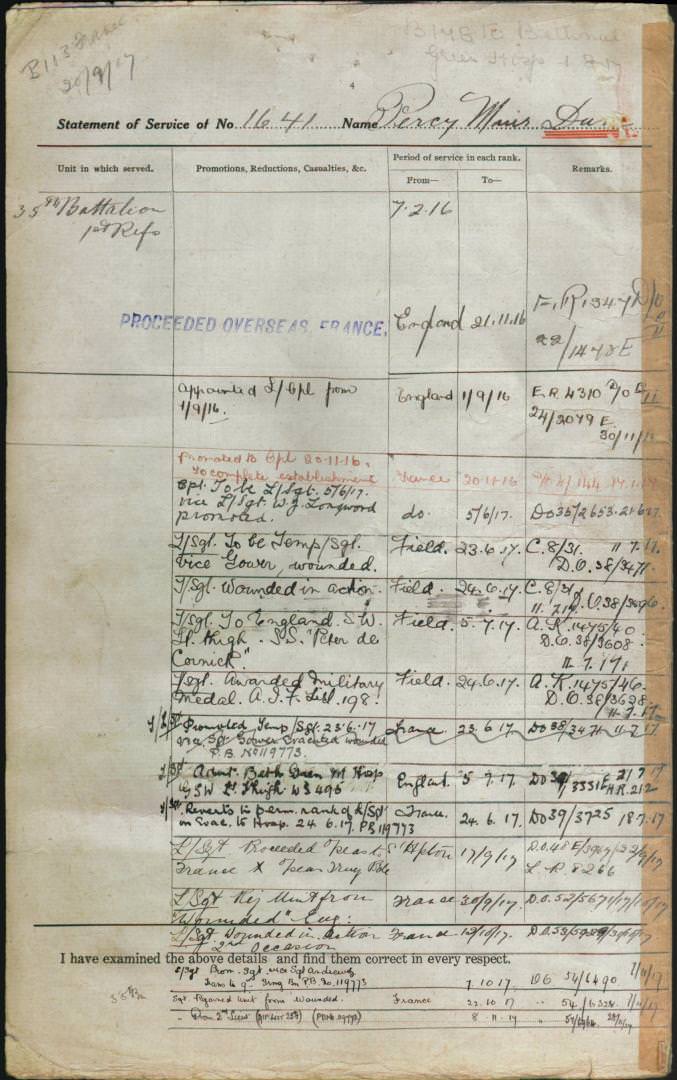
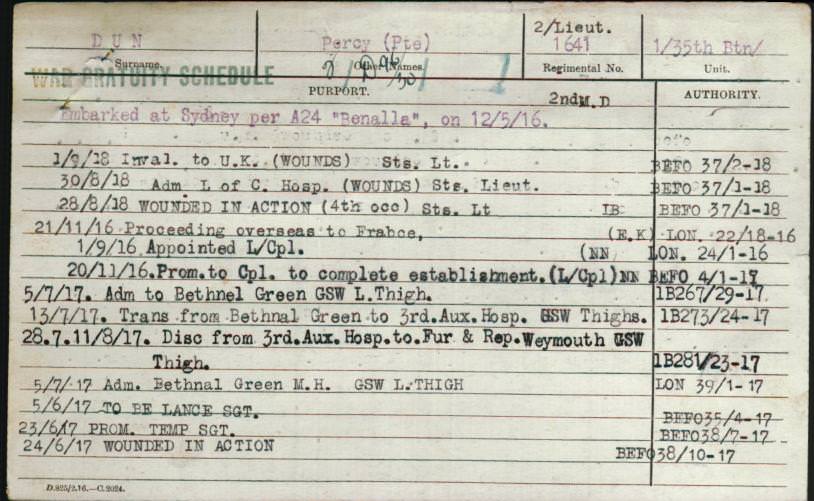
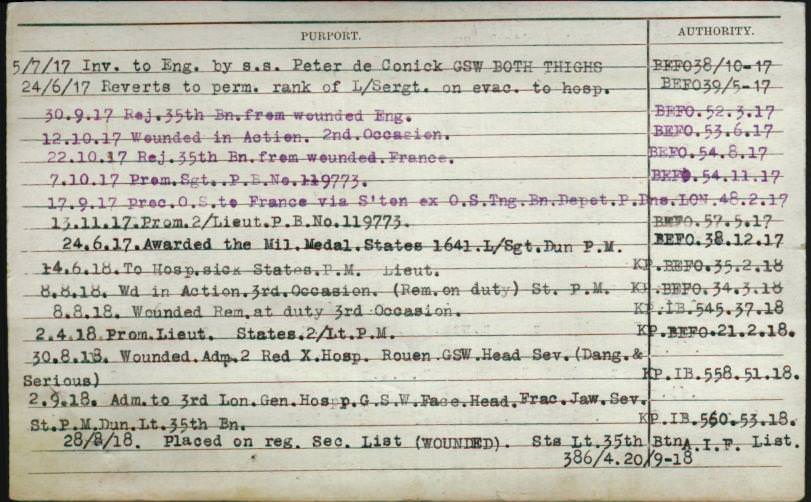
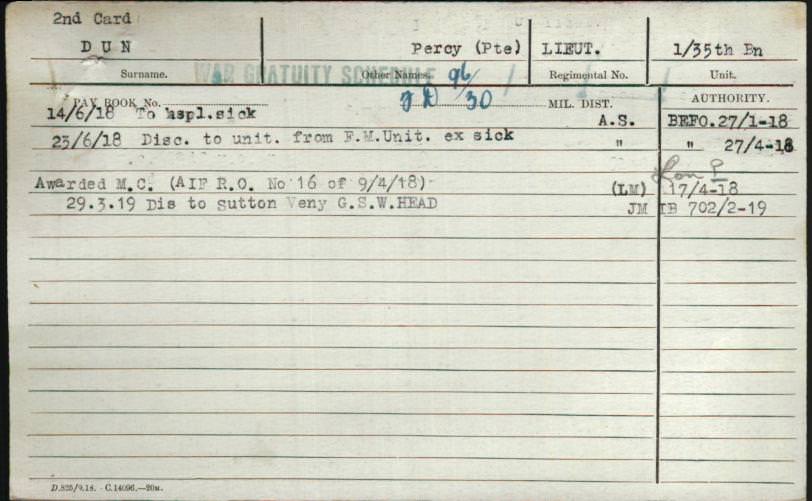


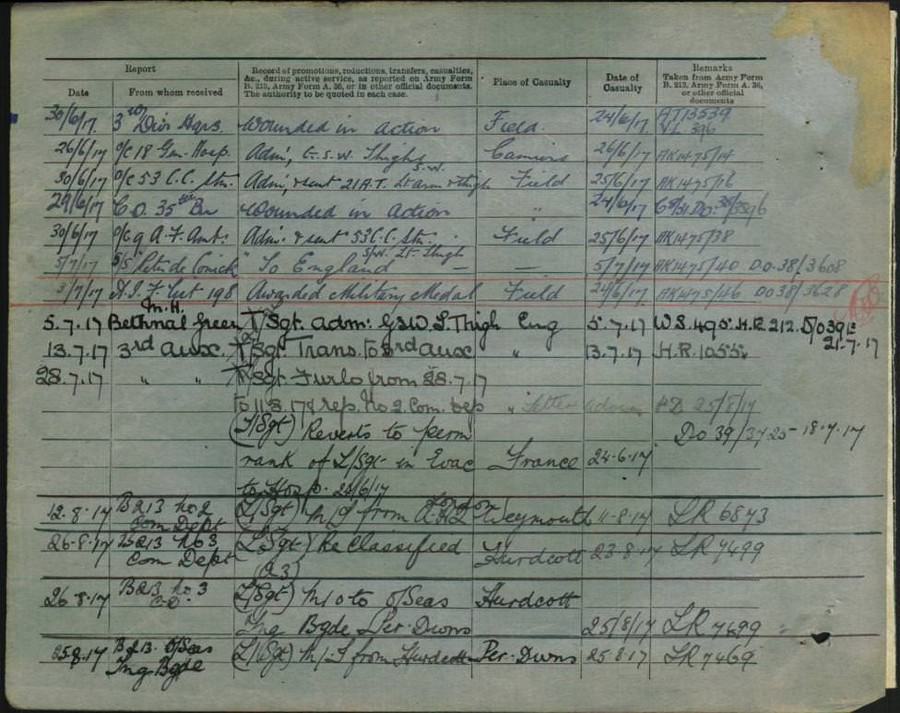
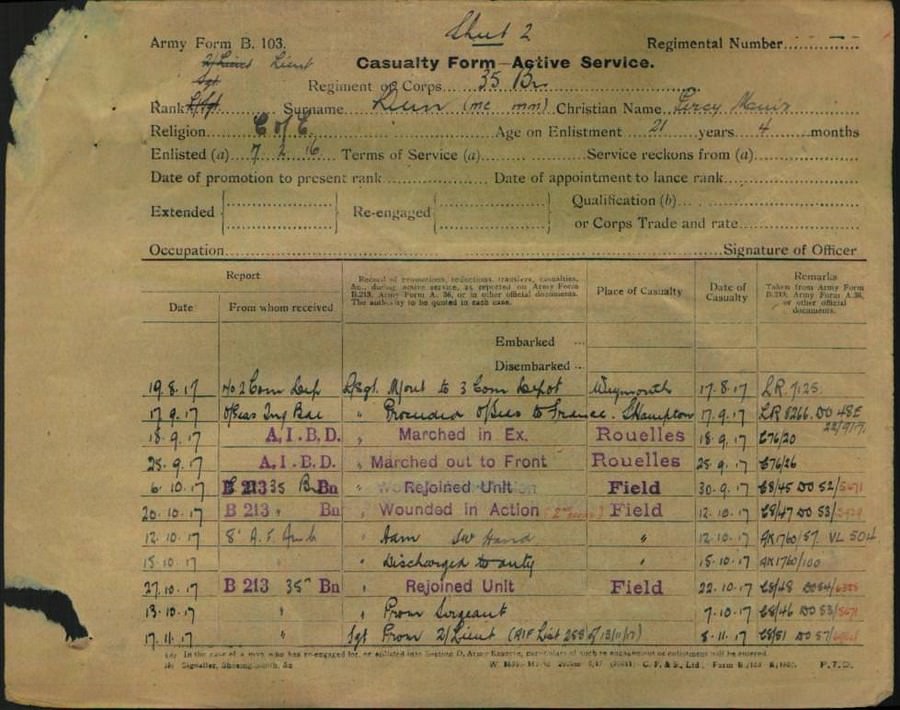
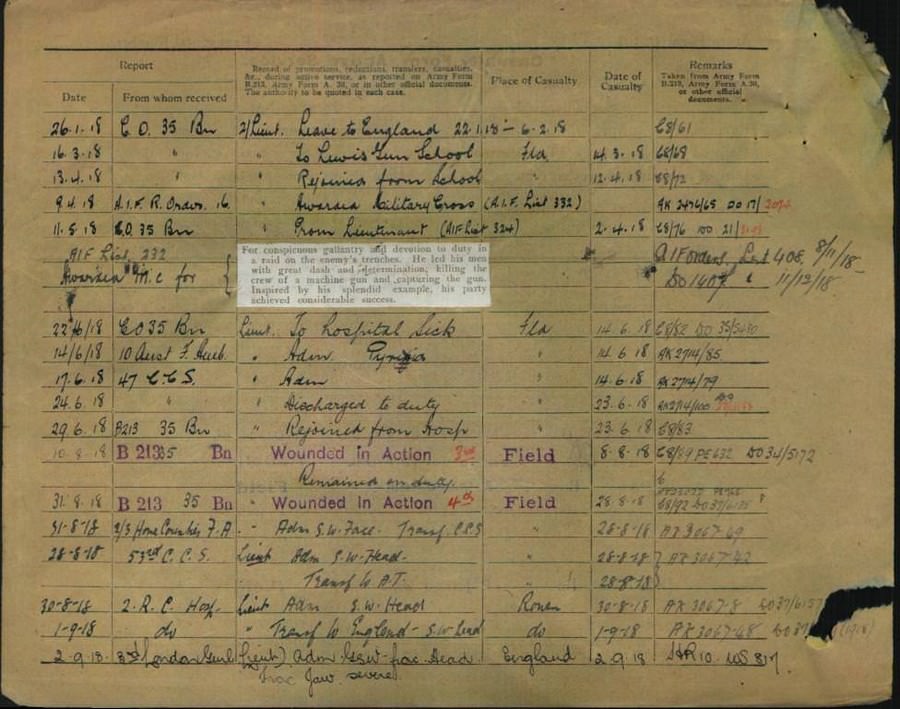



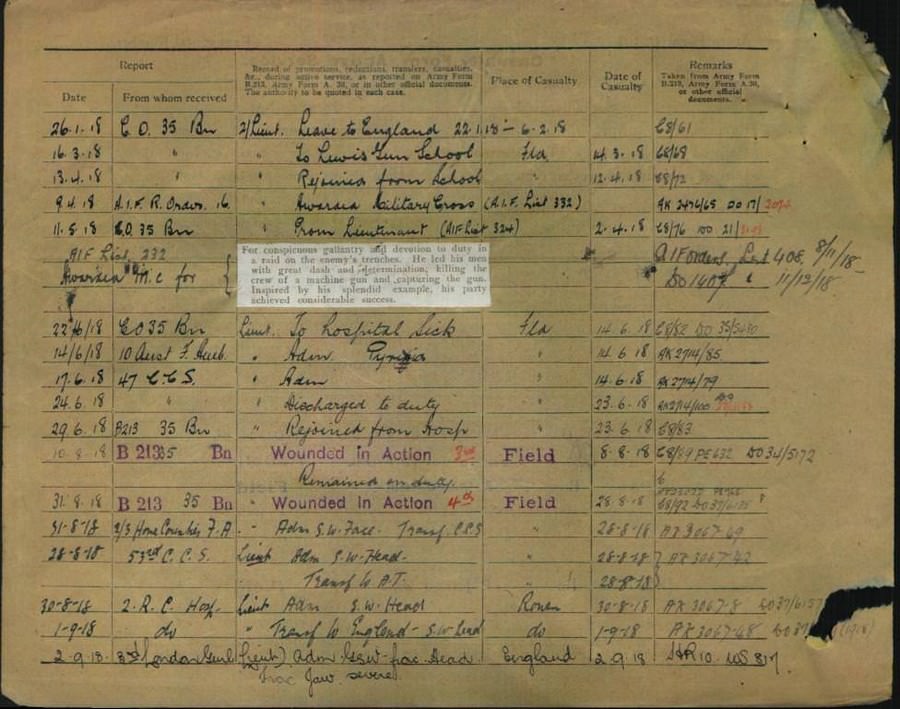
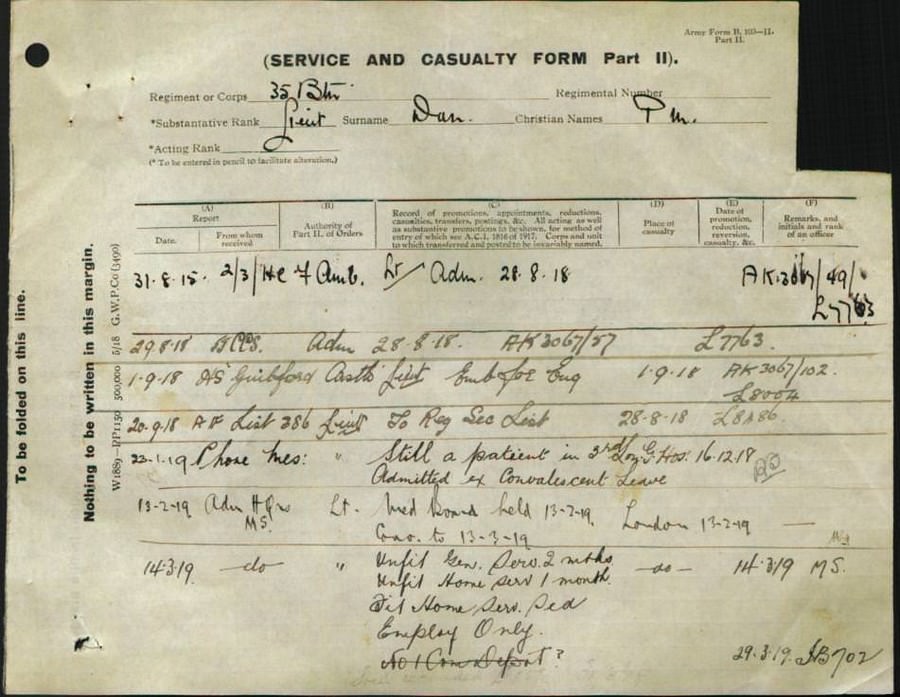

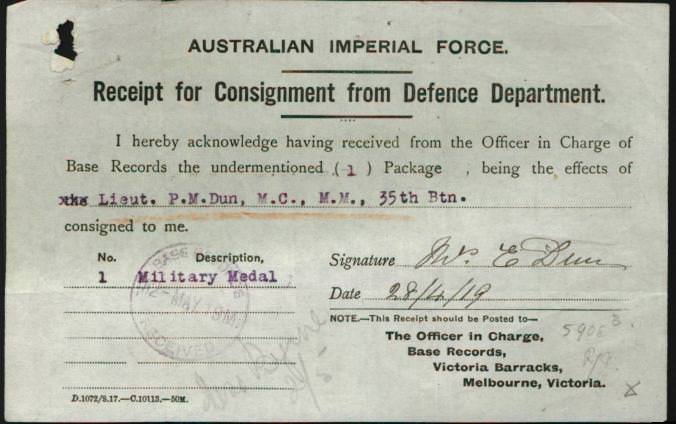
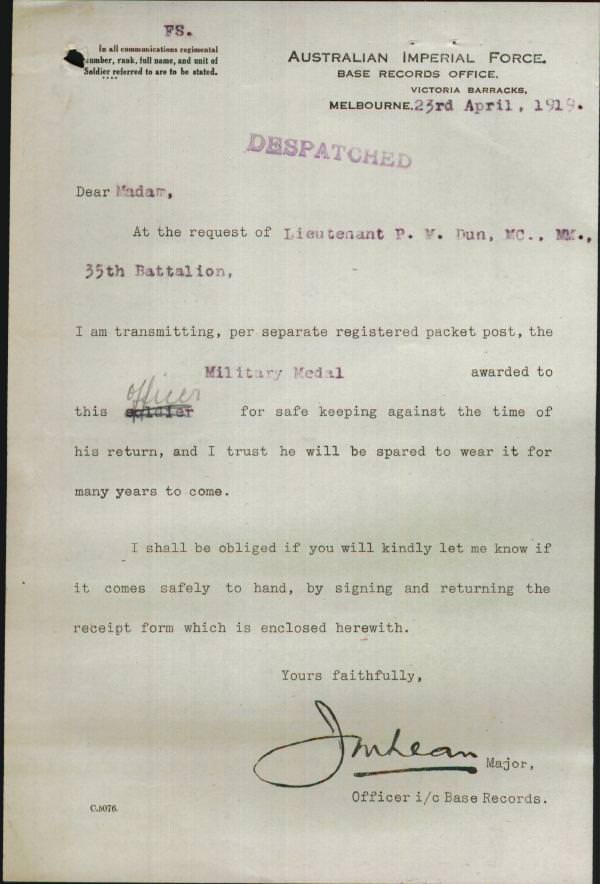
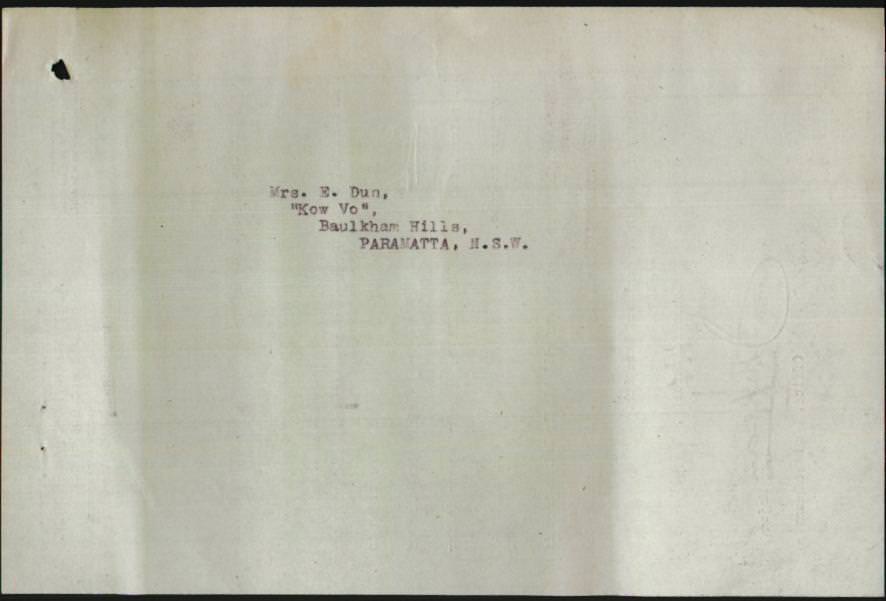

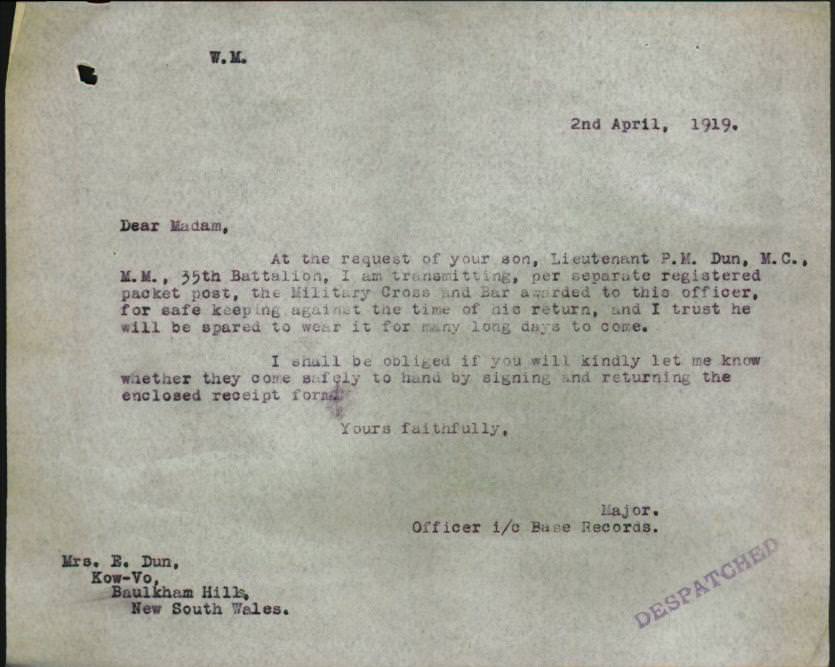

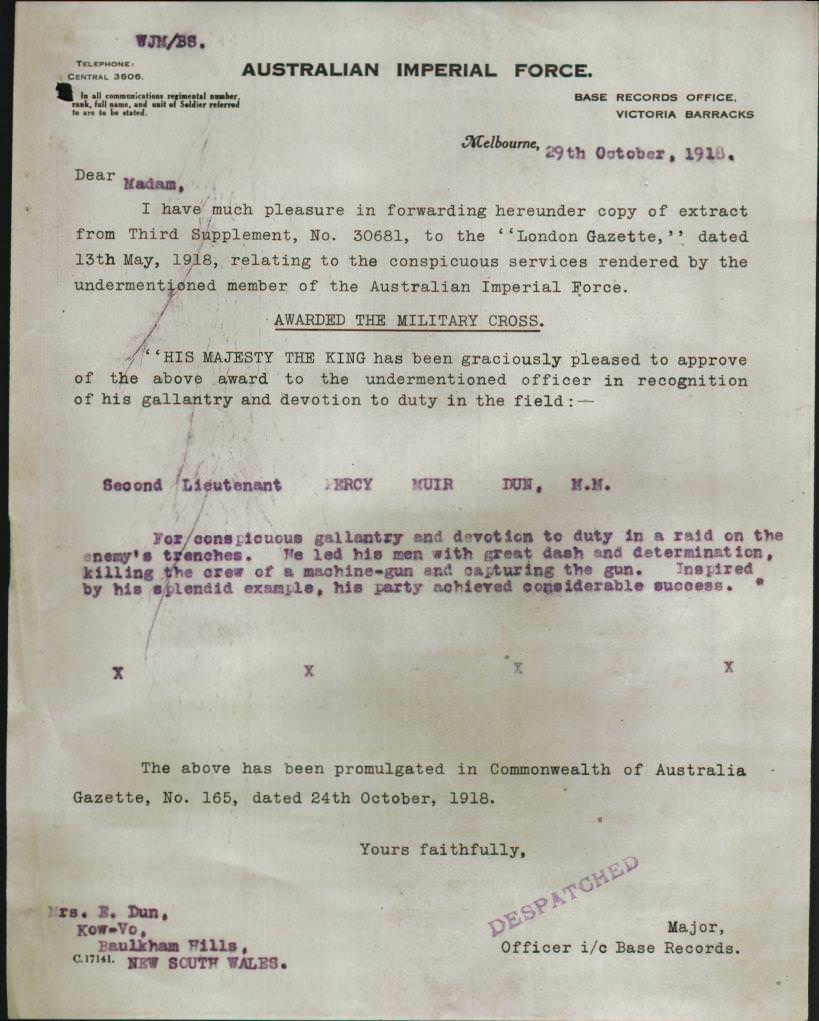

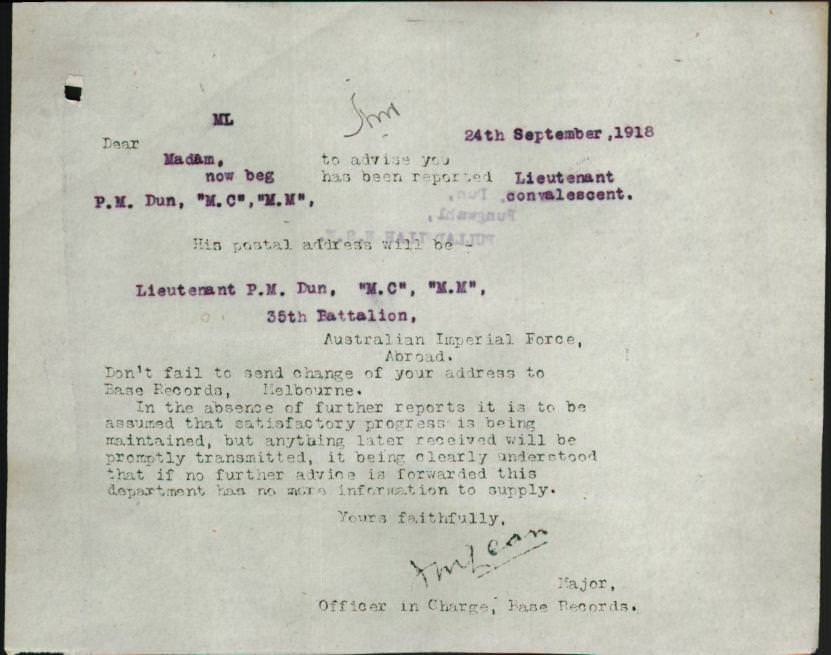


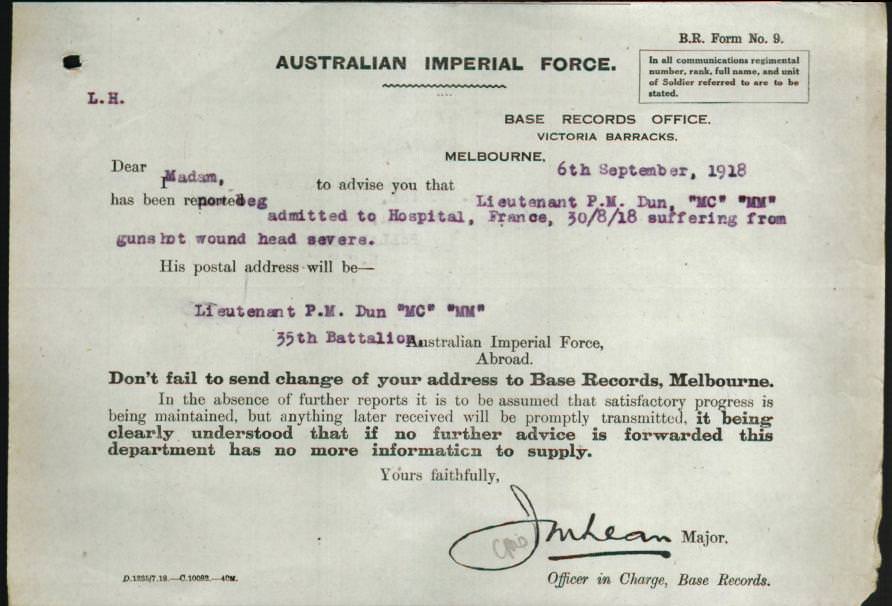
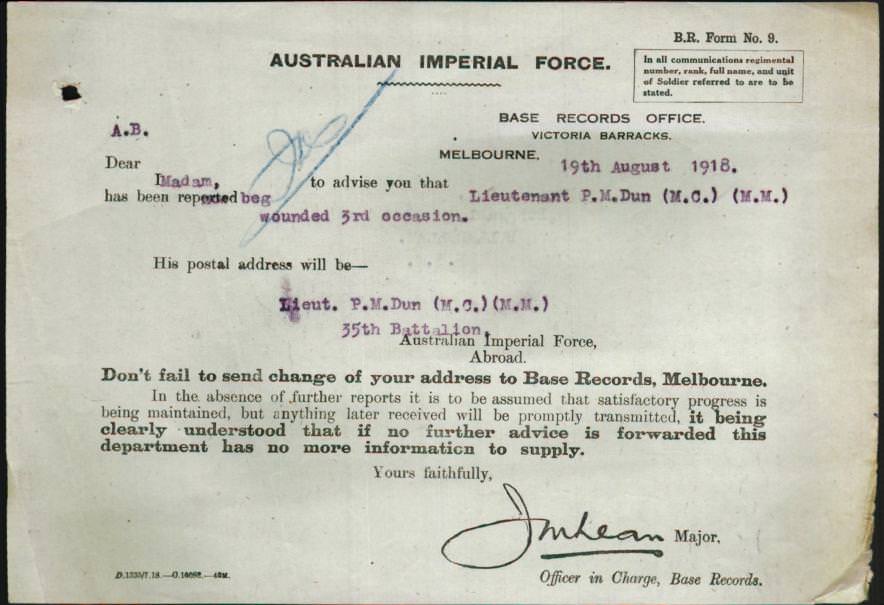
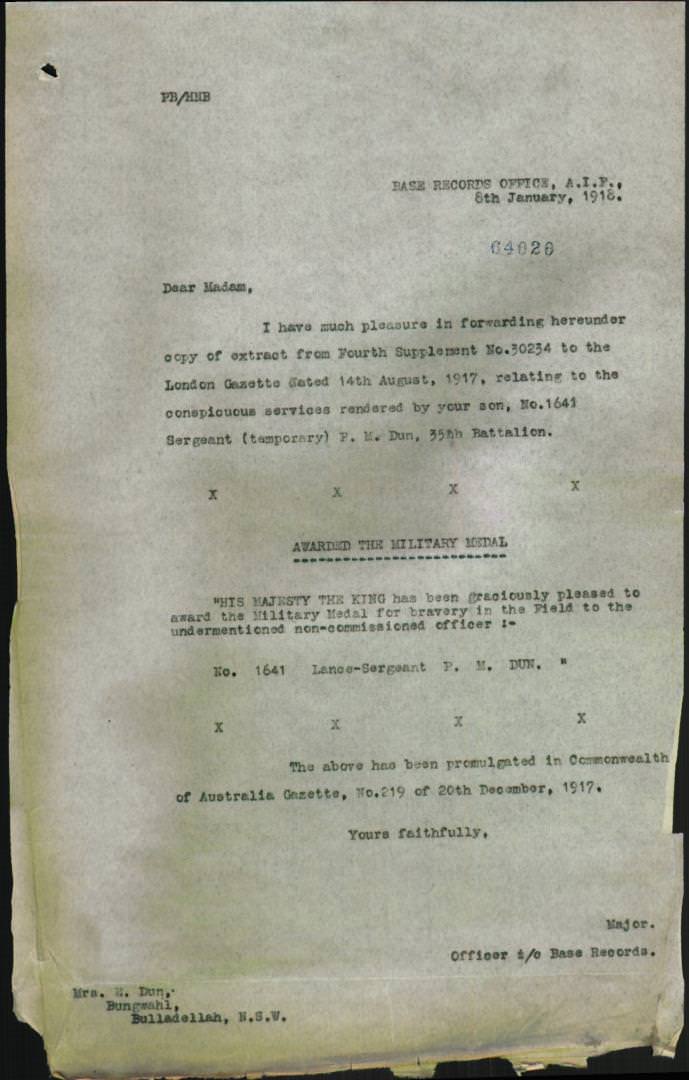

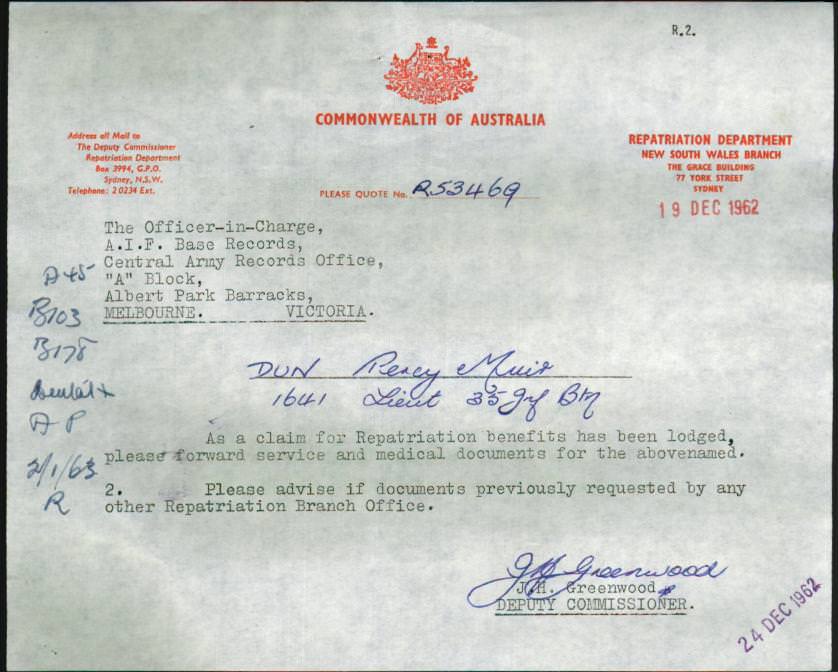
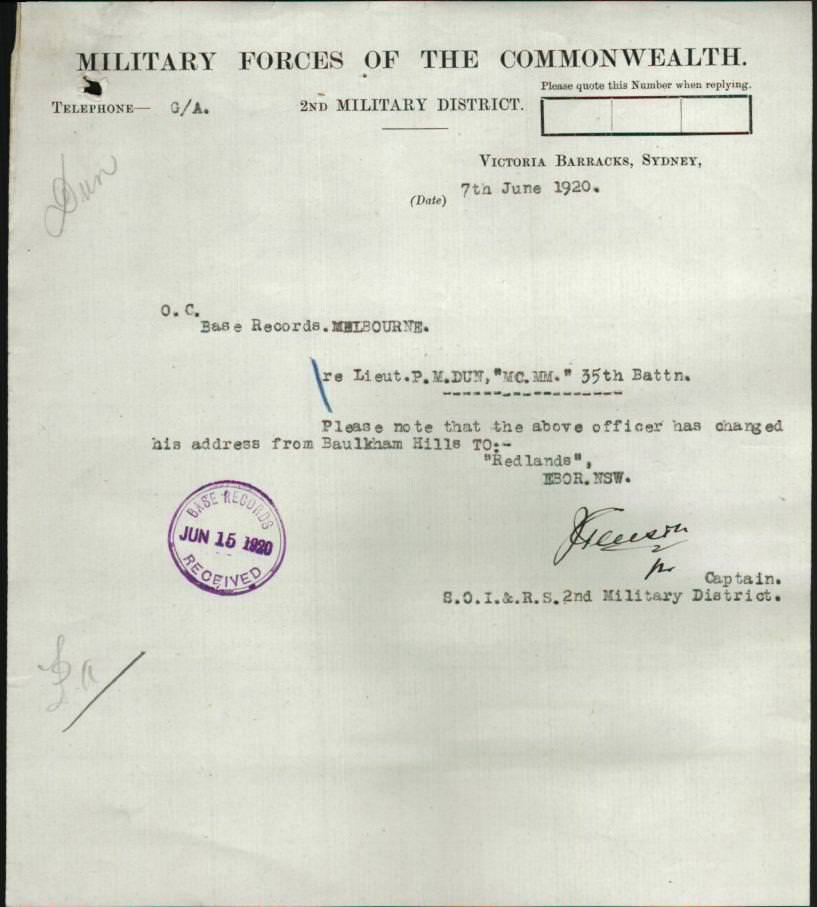
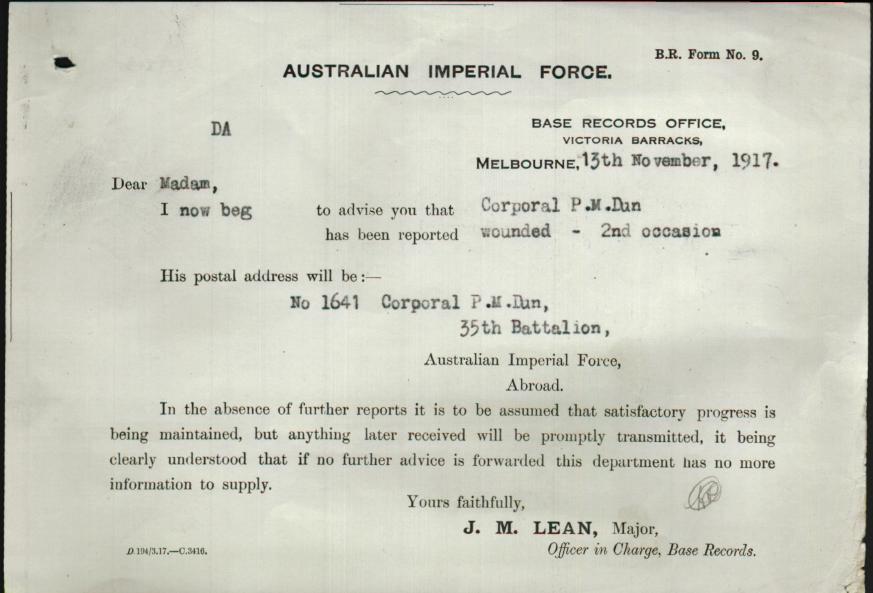
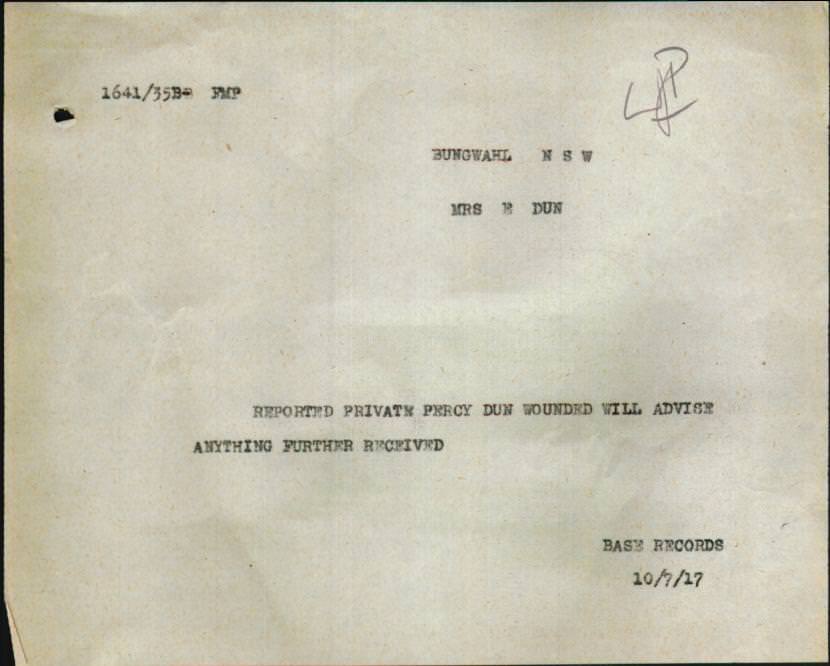

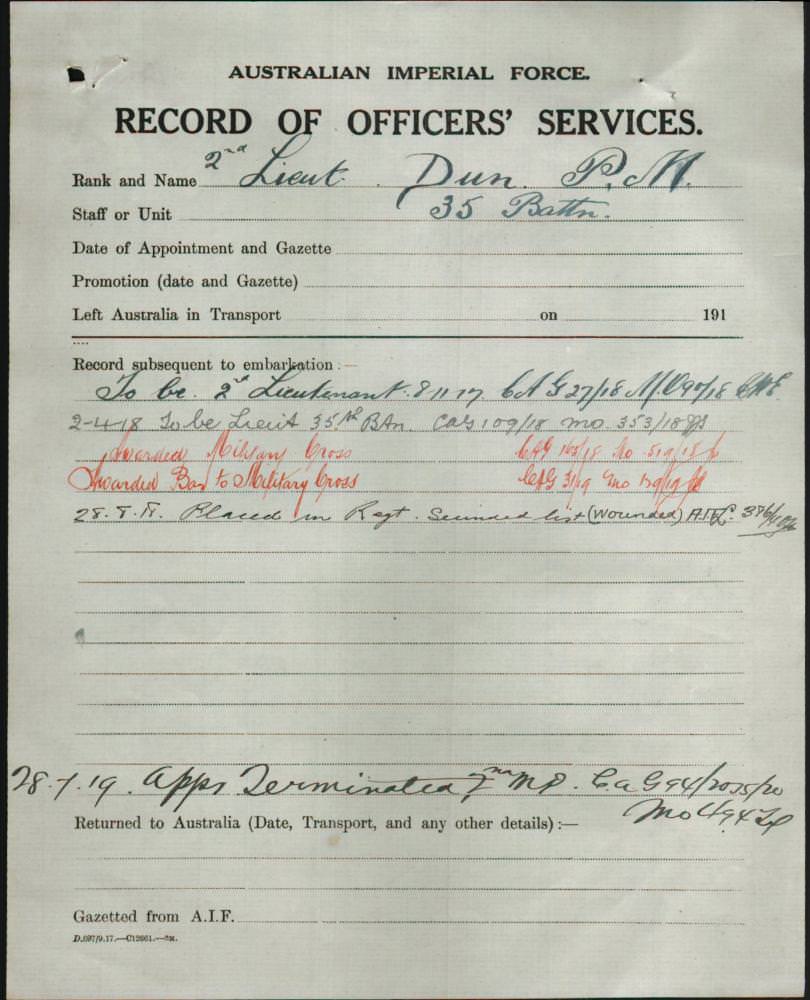
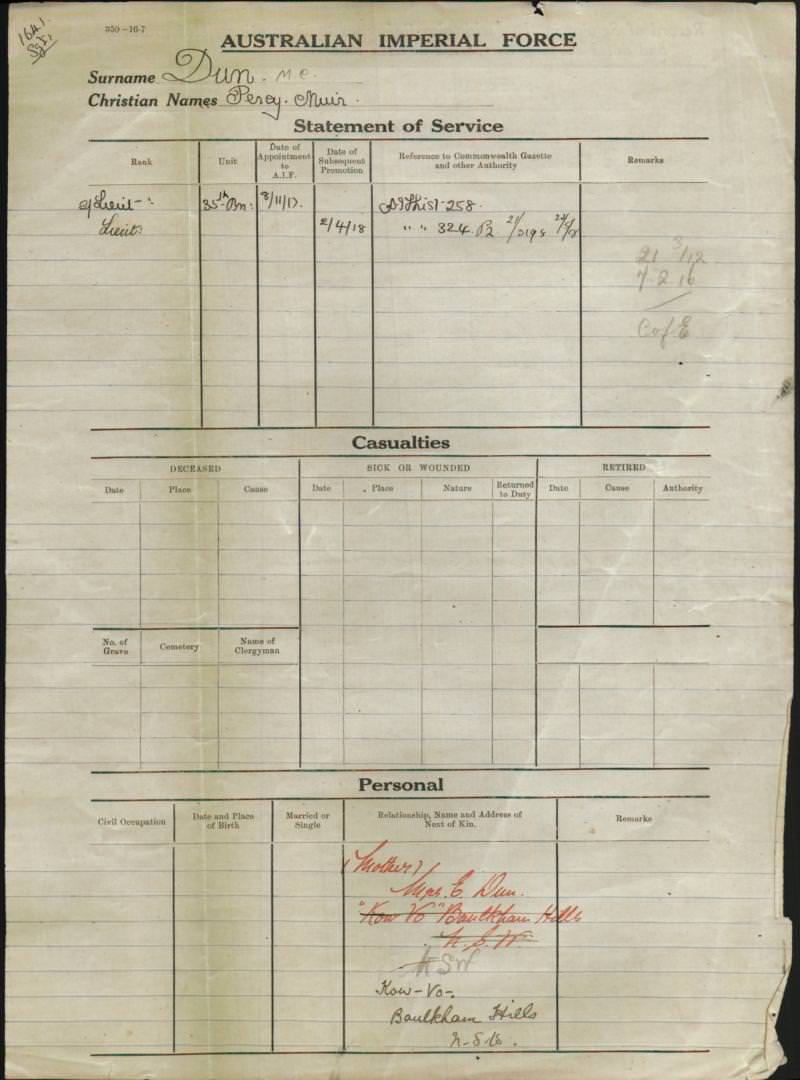


Under Construction; 30/05/2009-106/12/2019

Born: 1887. Ashburnham via Parkes, New South Wales, Australia. Birth Cert: /1887
Died: 12th of October 1917. Killed in Action Passchendaele, Belgium.
Father: John Dickson Day.
Mother: Archanna Day.
(Bill Durant: August 2019)
The Daily Telegraph (Sydney, NSW 1883 - 1930) Mon 5 Nov 1917

Western Champion (Parkes, NSW 1898 - 1934) Thu 3 Jan 1918

(BEAN; History of World War 1 Vol IV page 916)

Military Records






































© Commonwealth of Australia (National Archives of Australia)
Under Construction: 10/10/2006-19/08/2019.

Born: 11th June 1883. Parramatta, New South Wales, Australia. Birth Cert:15761/1883.
Married: 1910. Sydney. New South Wales, Australia. Marriage Cert:7172/1910.
Wife: Ella Marion Carr. nee: Sykes.
Died: 1st April 1975. New South Wales, Australia. Death Cert:19681/1975.
Father: James William Carr.
Mother: Rebecca Ruth Carr. nee: Lewry.
(Bill Durant: December 2019)
Henry Vince Carr, enlisted with C Company, 35th Battalion AIF on the 16th of March 1916 with the rank of Captain and left Sydney on board HMAT A24 "Benalla" on the 1st of May 1916.
12th October 1917
THE BATTLE OF PASSCHENDAELE I
At 1:30 am rain showers began. By 2:30 am it was raining lightly but steadily, by 3:30 fairly heavily. the infantry moved through the pitch dark in single file. In some battalions each man held on to the equipment of the man ahead of him; if touch was broken, those in front had to come back. The news that the line as reported by the 66th division was not held only just reached the incoming troops. Accordingly, in the right brigade (9th) the leading Company Commanders Captain: Clarence Smith JEFFRIES. V.C. and Captain: Telford Graham GILDER M.C. both of the 34th Battalion stopped their men at the entrance to Broodseinde railway cutting, and themselves went to make sure that their column might not run into the enemy.
At Keerselaarhoek Cemetery they found the tape duly laid, and met the officer of the 36th Battalion who had laid it, and by 3:00 am the time set, the 34th battalion was extended on its jumping-off position. But during the previous halt and afterwards, as it lay on the tape, the battalion was persistently shelled and suffered many casualties.
The first shell killed three signallers. Lieutenant: Albert Leslie WATSON. a signal officer of the 34th Battalion, a brave and enterprising leader who also was at the head of the column was severely wounded and all his staff hit. After establishing a forward command post Lieutenant: Thomas Fraser BRUCE 36th Battalion was also killed. Lieutenant Colonel: John Alexander MILNE. 36th Battalion supervising the assembly was knocked down by a shell but continued to command. Captain, Chaplain: Charles MURPHY was also wounded.
(BEAN; History of World war 1 Vol IV p911) Charles Edwin Woodrow BEAN
Only one Australian Division, the 3rd, was wholly employed in the days offensive. but the division was to capture Passchendaele an in spite of the depressing conditions, it was eager to achieve the distinction of doing so. One unit carried the Australian flag,to be planted in Passchendaele, and although officers and men in general were not enthusiastic concerning such "stunts" the Commander-in-Chief had been informed, and had told General: MONASH that, when this flag was planted, the news would be immediately cabled to Australia.
Some keen spirits looked on the operation simply as a dash for Passchendaele. One young company commander of Monash's reserve battalion, the 33rd, in face of a strict prohibition, led on his company as soon as the barrage fell. Starting from a line 350 yards in rear of the general alignment, the 3rd Division was out of touch with its neighbours from the outset. The heavy shelling on the tapes had made orderly disposition there almost impossible, as German Machine-Guns, undisturbed by the barrage now opened immediately, no opportunity offered of restoring proper formation.
The 9th Brigade went forward in the utmost confusion and a terrible mix up as reported by Captain: Robert Derwent DIXON D.S.O 35th Battalion at 6:40 am and "Great Confusion" was the description given by Captain: Henry Vince CARR 35th Battalion. Even on the ridge, the mud was difficult, the hope, if there ever was one, of catching up before the quick barrage finished.
The 9th Infantry Brigade's intendered direction lay not along the ridge and the Passchendeale road, but diagonally across them, and parallel to the railway, which most of the brigade could not see. As the jumping-off line was practically at right angles to the ridge, the brigade tendered to advance alone the heights. The Machine-Gun fire at the start came, on the 9th Brigade's right, from the ruined house near Defy Crossing; on its centre from, "Hillside Farm"; and on its left from Augustus Wood.
The pillbox opposite the centre was supported from the rear by a trench in which were Germans with Machine-Guns, and here occurred a delay which threatened to wreck to whole attack. it was not until an hour after the programme time that these places were rushed by the neighbouring portion of the line under Captain: Henry Vince CARR and Captain: Robert Derwent DIXON. D.S.O of the 35th Battalion. The trench contained 35 Germans and 4 Machine-Guns. Part of the line was also held up by a pillbox close to Passchendaele road near the highest point of the ridge.
Here there was practically no shelter from attack, but Captain Clarence Smith JEFFRIES. V.C. of the 34th Battalion managed to organise a party, with Sergeant: 21 James BRUCE and another N.C.O Corporal: 2036 Vere Cummings STEVENSON and a dozen men, and outflanking it, charged the place from the rear, capturing 25 Germans and 2 Machine-Guns. These actions set free the advance. The pillbox captured by Captain Clarence Smith JEFFRIES. V.C. being not far short of the first objective, the 34th Battalion dug in there.
Great loss had been uncured; the 34th Battalion had only three officers left and there were wide gaps in the line. The right flank had swung far away from the railway, along which the 4th Division was attacking, but on the left Captain: Telford Graham GILDER M.C. of the 34th Battalion who had been wounded by a Machine-Gun bullet, but was carrying on found the 10th Brigade digging in slightly to his left under Captain: LATCHFORD, 38th Battalion, and fell back seventy yards to join it.
The Advance to the second objective was to begin at 8:25, the low clouds had opened, and fleecy cirrus with patches of blue were widening overhead and the sun had come out. The 9th Brigade had been so late in reaching the first objective that, while most of the 34th Battalion dug in, the 35th Battalion, allotted for the second phase, moved straight on. Standing on the Passchendaele road, Captain: Henry Vince CARR and Captain: Robert Derwent DIXON. D.S.O of the 35th Battalion endevoured to decide where the barrage then was; at first Carr thought it may be behind them, but finally decided that it was ahead.
The confusion at the start had split the brigade into mixed parties of all battalions and many of the 34th went on with the 35th, the main body of which, about 100 in all, now advanced along the south-eastern side of the ridge in order to catch the barrage. The hour was probably a little before that for the second advance. A German Machine-Gun in the gap between the brigade's right and the railway immediately opened with deadly effect.
Major: John Bruce BUCHANAN 36th Battalion, the senior forward officer was killed. At this critical juncture Captain: Clarence Smith JEFFRIES. V.C. of the 34th Battalion, again accompanied by Sergeant: 21 James BRUCE, led out a few men from the first objective and made for the gun. it was shooting in short bursts, and he was able to work up fairly close. Seizing a moment when it was firing to the north, he and his men rushed at it from the west. It was switched round, killing him, and sending his men to the ground.
But when its fire eased they worked round it, rushed the position, seized 25 Germans and 2 Machine-Guns. This gallant and effective action Captain: Clarence Smith JEFFRIES. V.C. was posthumously awarded the Victoria Cross for removing the chief danger to the advance along the crest, but as soon as the 35th Battalion crossed to the eastern side of the hill it became the target of a number of field and heavy guns which, from the hedges and other cover in various parts of the landscape, fired over open sights.
After passing a corpse on its right, the 35th Battalion settled down on what its officers took to be the second objective, although on the extreme right they were actually short of the first. Captain: Henry Vince CARR, now the senior officer on the spot, reported; 8:35. On objective, with about 100 Captain: Robert Derwent DIXON. DSO and three officers. Casualties 25 or 30 per cent. Captain: Henry Charles Dight CADELL M.C Lieutenant: Charles Teesdale MAIN Lieutenant: Keith Maitland DAY reported killed and Lieutenant: Frank HORNE Lieutenant: Christopher Kyffin MEARS Lieutenant: Charles John HENRY were wounded. Prisoners sent back 400-500. Contact on flanks uncertain, being heavily shelled.
Three posts were established under surviving officers, right Lieutenant: Norman Beade D'ARCY M.C centre Lieutenant: Joseph Francis ADAMS left Lieutenant: Harold Sydney WYNDHAM. In this brigade the battalion for the final objective was the 36th, and a report came along that it had gone through. Actually, it had advanced with the 35th, but, on the left, penetrated to the second objective, which bad been reconnoitered during the previous halt by the commander of the company Captain Robert Austin GOLDRICK. M.C.
He went up the road towards Passchendaele. The barrage, he said afterwards was no hindrance to him, although he left the line lying as close to it as possible "or where he thought it was." He was unable to detect the intensification of the barrage for the second phase, but led his men forward at the proper hour.
As no other battalion was there, he now established the line with its left on the road 600 yards from the church, about the point reached by the 66th Division's troops on October 9th. In front of the position Captain: Robert Austin GOLDRICK. M.C. and Lieutenant E.H FLEITER (39th Battalion) found hidden in a shell hole men of the 66th Division. One had a broken arm, the other trench-feet. They took the Australians at first for Germans. When reassured,"we knew the Australians would come," they said, 'We prayed hard."
From the direction of the church, which lay straight down the highway, no fire came. two Germans ran up the road and surrendered. South-east of the village, along the Moorslede road, were the Germans who seemed "very windy," and near the road two 5.9-inch howitzers began to blaze at the troops digging in.
The 9th Brigade had taken its second objective and the 10th its first, but the position of the officers in charge of these advanced lines was full of anxiety. On the eastern slope Captain: Henry Vince CARR 35th Battalion, the senior officer in this part of the 9th Brigade's front, could see the 4th Division somewhat ahead of its right, and by 10:55 he had discovered that the 36th was on the left, but farther left than the 10th Brigade was far behind on its first objective . The German Guns ahead were sniping with dreadful accuracy. Carr on the western slope, sent back for instructions: "what am I to do?"
Word of the true situation reached headquarters slowly. As on the 9th, the first news was all encouraging. General: MONASH in the Ypres ramparts heard shortly after 7 that both brigades were "well away"; but by 8:26 he had ample evidence that the first objective was taken. At 9:25 the intelligence officer examining prisoners (Lieutenant: Frederick Morley CUTLACK Official War Correspondent) reported having heard from the wounded men that the second objective had been reached.
At 10:28 headquarters was informed of a statement of a wounded man, that the 38th Battalion had gone through. A further report that Australians had been seen at Crest Farm although quickly contradicting but probably true nevertheless. Which confirmed Monash's impression that his division was succeeding. Concerning the New Zealand brigade on his left, however, there was no word until, at 10:50, there arrived the tragic information that the New Zealand Division was stopped by the enemy alone the entire front.
Monash has already heard at 9:55 that the 10th Brigade was held up by fire from Bellevue Spur. Believing that his division was still advancing, he asked that every gun that the New Zealand Division could spare should be turned upon that ridge to suppress the fire. Meanwhile, he would order the reserve (39th) battalion of the 10th Brigade to be ready to assist in holding the ground already won. The reserve battalion the (33rd) of the 9th Brigade he was still keeping back to assist in the capture of Passchendaele.
Shortly after noon news of the true situation arrived. Lieutenant Jackson of the 40th Battalion had established at Waterfields pillbox near the Ravebeek a forward report-centre from which a series of messages, admirably accurate, was flashed by lamp to the headquarters of Lieutenant Colonel Lord of the 40th Battalion. Thus Brigadier General McNicoll of the 10th Brigade was able to inform Monash of the precise position of Giblin's Line. He added that the situation was very serious and the casualties very heave. At the same time from the front line of the 9th Brigade arrived a pigeon message, sent by Captain: Richard GADD of the 36th Battalion.
We are on the Blue Line (second objective) with composite force all three battalions, both flanks in the air.
The New Zealand Division was to make a second attempt at 3:00 pm, and Monash was of the opinion that from the 9th Brigade, well forward on the ridge, patrols might still work northward around Crest Farm. His reserve, the 33rd Battalion (9th Brigade), was accordingly ordered to attempt this at 4:30 pm and the 10th Brigade's forward line being meanwhile reinforced by its own reserve, the 39th Battalion.
These orders went out, but none of them were fulfilled. The New Zealand Division had been defeated by obstacles which no hastily renewed bombardment could have overcome. no infantry in the world could have crossed the Ravebeek mud, penetrated the dense wire, and attacked the crowded pillboxes of Bellview with the assistance of a barrage which did not even screen the advance. No blame can attach to the artillery. Its commander, according to the New Zealand official history, had reported on the previous day that his guns might be unable to give efficient support.
This magnificent division, which lost nearly 3,000 men, had been held up in almost exactly the same position as the 49th three days before-the left brigade penetrating half-way to the first objective, the right stopped almost at the start.The Germans were reinforcing. The New Zealand battalion commanders knew that their men had no chance of succeeding by renewed attack, and the order was eventually cancelled.
As for the Australians, of the two battalions that MONASH had now ordered to participate, the 39th had already to a large extent been involved in the fighting, and the 33rd, endevouring to reach its position of readiness for outflanking Passchendaele,had suffered great loss. No less than 6 of its Officers were killed or mortally wounded. Captain: Wilfred Frank HINTON in command of the forward company, Lieutenant Leonard Rockley BROWNLOW Lieutenant: Thomas Acheson ARMSTRONG Lieutenant: Albert George KILPATRICK Lieutenant William REES-REYNOLDS and Lieutenant: Norman Francis GOBLE.
By the time Lieutenant Colonels Henderson DSO 39th Battalion and MORSHEAD attempted to carry Monash's orders, they found that the attacking force of both brigades was back almost at its starting point. What had happened was as follows.
Neither Major: GIBLIN near the Ravenbeek nor Captain: Henry Vince CARR on the ridge had received their messages sent several hours earlier. The 9th Brigade's line was still being battered by the German Guns. Captain: Richard GADD 36th Battalion, whose troops were being wiped out, informed Captain: Henry Vince CARR 35th Battalion that Lieutenant Colonel: John Alexander MILNE D.S.O 36th Battalion had now come forward to Hillside Farm. CARR accordingly sent Captain: Robert Derwent DIXON. D.S.O with GADD to explain to Milne the desperate nature of their situation. Milne said that he would try to get their troops relieved after dark, but till relieved they must hold on.
(BEAN; History of Word War 1 Vol IV page 921) Charles Edwin Woodrow BEAN
Meanwhile, however, the German artillery was annihilating some parts of their line. All leaders of Carr's three posts were out of action. Lieutenant: Joseph Francis ADAMS was Killed in Action and Lieutenant: Norman Beade D'ARCY M.C and Lieutenant: Harold Sydney WYNDHAM were wounded. Of the remaining officers of the 36th Battalion, Major: John Bruce BUCHANAN and Lieutenant: Fredrick William PUTNEY had been Killed in Action and Captain: Robert Austin GOLDRICK M.C wounded. Farther back Lieutenant: Sydney COOK had been Killed in Action and Lieutenant: William WAND and Lieutenant: Herbert Reginald MAILER were wounded.
At 3 o'clock rain began to fall steadily. at 3:15 pm Captain: Richard GADD 36th Battalion, thought agreeing with Captain: Henry Vince CARR 35th Battalion that to hold on meant annihilation, refused, in view of his Colonel's orders, to retire. Carr consented to wait while Gadd again sent word to Lieutenant Colonel: John Alexander MILNE D.S.O. Carr himself at 12: 30 had sent Captain Robert Derwent DIXON. D.S.O to the headquarters of the 35th Battalion at " Seine", from which no word had been received all day.
At 3:45 pm, no reply having come from Milne, and Dixon not having returned as he had been kept at 35th Battalion headquarters awaiting the arrival of an order from brigade headquarters concerning the projected operation by the reserve battalion, Gadd agreed to withdraw and Carr sent along the line a note: The 35th Battalion will retire.
When visiting Gadd, Carr had warned the troops of the probable order to withdraw, and he now saw that the left had already begun to retire. He told men whom he passed to get back as fast as they could to the 34th Battalion (which he believed to be on the first objective). Captain: William James GORDON M.C 36th Battalion, strongly dissatisfied with the order, went straight to Lieutenant Colonel: John Alexander MILNE D.S.O urged that the forward position was tenable, and with Milne and Major: John Martin HAWKEY M.C rushed out to stop the withdrawal. But it was too late.
The 34th was not, as Captain: Henry Vince Carr 35th Battalion, believed, on the first objective. The Commander of the line, Captain: John William RICHARDSON 34th Battalion, on hearing of the extreme weakness of the force at the second objective, had reinforced it. He and his only remaining officer's Lieutenant: James Clement BURGES Lieutenant: Bruce Gray McKENZIE Lieutenant: John Abbott LONGWORTH had all been Killed in Action while organising on the first objective, and the first objective now lay empty. The retiring troops, being without orders as to the position to be taken up, streamed back past Milne's headquarters.
All that Hawkey, Gordon, Gadd, and others could then do was to lead a fraction of them forward again to the first objective, where they remained during the night. Captain: Robert Derwent DIXON. D.S.O. with Captain: John Grieve PATERSON adjutant of the 35th, went up to organise the 35th there, but could find none of it's men. When eventually re-formed the remnant of the 35th was temporarily attached as a Company to the 33rd Battalion.
9th-12th October 1917 saw the 3rd Division, 9th and 10th Infantry Brigade in action during the Battle of Passchendaele, which saw massive losses and suffering in the Australian ranks. The casualties numbered 3,199 men in 24 hours during the height battle. The 34th Battalion lost every officer that day, either killed or wounded including their Medical Officer, Major: Gother Robert Carlisle CLARKE and some of his staff were killed while dressing the wounded. The spirit of some of the wounded is illustrated by the case of Corporal: 3170 Winsleigh Alexander MURRAY 35th Battalion, (formerly a Methodist Minister from Newcastle) gave up his place in a queue waiting for stretcher bearers and was never heard of again.
The Battle of Passchendaele saw 60 Officers and 1,322 other ranks loose their lives.
9th Infantry Brigade Casualties.
| 33rd Battalion. AIF | 11 Officers | 273 Other ranks |
| 34th Battalion. AIF | 15 Officers | 323 Other ranks |
| 35th Battalion. AIF | 18 Officers | 296 Other ranks |
| 36th Battalion. AIF | 15 Officers | 383 Other ranks |
| 9th Machine Gun Company. AIF | 1 Officer | 36 Other ranks |
| 9th Light Trench Mortar Battery. | - Officer | 11 Other ranks |
The 34th was not, as Captain: Henry Vince CARR 35th Battalion, believed, on the first objective. The Commander of the line, Captain: John William RICHARDSON 34th Battalion, on hearing of the extreme weakness of the force at the second objective,had reinforced it. He and his only remaining officer's Lieutenant: James Clement BURGESS Lieutenant: Bruce Gray MCKENZIE and Lieutenant: John Abbott LONGWORTH had all been Killed in Action while organising on the first objective, and the first objective now lay empty.
(BEAN; History of World War 1 Vol IV page; 922)
(BEAN; History of World War 1 Vol IV page; 912-13)

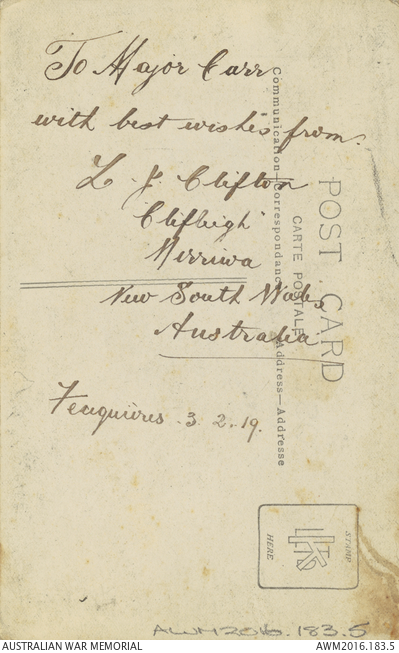
Family Information
Henry was a 33 year old Civil Servant, Croydon, New South Wales upon enlistment. His parents James and Rebecca Carr were married in 1861 in Sydney, N.S.W. and had at least 14 children, 10 girls and 4 boys. Mary A Carr born 1862 at Parramatta, N.S.W. Birth Cert:11626/1862. Emily Carr born 1863 at Parramatta, N.S.W. Birth Cert:11662. James Carr born 1865 at Parramatta, N.S.W. Birth Cert:13101/1865 and died in 1880 at Parramatta, N.S.W. Death Cert: 9254/1880. Beatrice Carr

Divorce papers Ella Marian Carr - Henry Vince Carr. Item Number; 281/1948.



























Under Construction; 27/08/2006-20/09/2015.

Born: 1894. Aberdeen, New South Wales, Australia. Birth Cert:32330/1893.
Died: 1st July 1917. Messines Ridge, Belgium.
Father: Joseph Tripp.
Mother: Margaret Tripp. nee: .

Here the Battalion transferred to S.S."Aragon", E867. Some Australian Details were on board, also a number of Tommies going to England on Furlough. Devonport was reached on the 23rd June, the Battalion disembarked at Plymouth at 1:00 pm and en trained during the afternoon for Amesbury, arriving at midnight and marching to hutments at No: 1 Camp, Larkhill. Here the Battalion settled down to hard training, which included Route Marching, Trench Digging, Bomb Practice, Musketry and general Camp Routine. Later the Battalion moved to the No: 25 Camp and finished off their training, which included six days' battle practice and field work at the Bustard Trenches.
The 34th Battalion left Larkhill on the 21st November and en trained at Amesbury for Southampton, embarking on the S.S "Arundel". The transport section left by S.S. "Princess Victoria". The Battalion arrived at Le Harve, France on the 22nd November 1916. Disembarkation commenced at 8:00 am and the Battalion marched to No;1 camp on the Hill, arriving at 2:00 pm. The men carried heavy loads, in some cases amounting to miniature Q.M.' Stores. The march over cobblestones was very tiring, notwithstanding the many route marches which had been carried out at Larkhill. However, after bathing their feet and receiving treatment, as well partaking of a good meal, some spent a comfortable night.
The following morning the Battalion moved to Le Harve Railway Station, leaving D Company behind. On arrival at the Station en training commenced at 8:00 am and the train left at 11:15 am. The journey was slow and occupied until 4:30 pm on the 24th. On arrival at Bailleul the men de trained and marched to Outtersteene. D Company arrived at 4:00 pm the following day. The Battalion rested here in billets for two days previous to taking over garrison duties in the Line at Armenties. The Commanding Officer Lieutenant Colonel. Malcolm St John LAMB. with the Adjutant, Company Commanders, N.C.O's and Specialists went into the Line to inspect Trenches, Stores, Plans and to arrange for the taking over this Section of the line on the following day.
The specialists and N.C.O's remained in the Line. On 27th November the Battalion went into the Line in the L'Epinette Sector. The men were taken up by motor lorries as far as the Square near Houplines Station, and marched via Butterne Avenue and Willow Walk to the Line, carrying their packs and blankets into the trenches. Lewis Gun ammunition was taken into the Line with the tin cases. The going was difficult owing to the conditions of the Trenches and the heavy and bulky loads. Later the blankets were dumped near Tussage Dump, from which most of them disappeared. This was the main incident of our relief in the Line.
17th May 1917.
(2) On the 17th of May the Germans tried to raid the 34th Battalion at Le Touquet. The enemy this time employed the British method of a very short, though heavy, preliminary bombardment. The preliminary registration however had been observed and the Australian counter-barrage came down within 10 seconds of the S.O.S signal fired by Lieutenant: 4559 Frederick Murchison WAUGH. M.C. 34th Battalion. A party of Bavarians attempted to enter by a gap in the front line. One climbed the parapet and said "Hands Oop!" He was at once shot, and fell dead into the trench. Lewis Guns, in particular that of Private: 1416 Joseph Edward KIRK. M.M 34th Battalion, drove the enemy off.
On the 18th of May the previous night's attempt against the 34th Battalion was repeated after a short heave bombardment. On the S.O.S. being fired by Lieutenant: 1118 William Wright EDMONDS. M.C. 34th Battalion, the protecting barrage again came down instantly, but the enemy entered a gap near a sector in which cylinders had been installed for an impending release of gas. Working alone the line, they bombed a Lewis Gun Team, wounding three. The remaining men, Lance Corporal: 1530 James HAM D.C.M. 34th Battalion and Private 1248 Bertram Guy TAYLOR M.M. 34th Battalion, continued to fire, and killed all five intruders.
Lieutenant: Benjamin Greenup BRODIE and the scouts afterwards went out, driving back the German covering party and stretcher-bearers, brought in a wounded Baverian Pioneer, and evidence and identification from 11 Germans who had been killed.
7th June 1917.
They made it to the "jump off" point but only just with some of the men from the 9th and 10th going straight over the top without stopping. The mines went up and the attack commenced behind a protective barrage. The II Anzac Corps were attacking on the right with their objective being the southern shoulder of the ridge which included Messines, the Dover and St Yves areas as far south to the east of Ploegsteert Wood.
Major General Sir John MONASH's 3rd Division had to contend with a tricky 3 mile approach out of Ploegsteert Wood and after the German gas attack, but they were not deterred. The 9th Infantry Brigade under Brigadier General: Alexander JOBSON and the 10th Infantry Brigade under Brigadier General W R NICHOLL had just made the jumping off point but some of the men did not stop, going straight into the assault from the approach march.
Their objective lay between St Yves and the Douve. The mines at Trench 127 and Trench 12 at Factory Farm were laid to aid this task. The explosions erupted a few seconds before zero hour and created craters of 200 feet in diameter, completely obliterating the German defense line as the 9th and 10th Infantry Brigades went over the top. The mine crates forced the 9th and 10th Brigades to veer to the left and right which caused some confusion with the main assault. It is testimony to the quality of training that every man knew the ground, tasks and objectives so well.
Private: 1804 John CARROLL 33rd Battalion, rushed the enemy's trench and bayoneted four of the German occupants. He then noticed a comrade in difficulties and went to his assistance, killing another German. He then attacked single handed a German Machine Gun Team, killing all three of them and capturing the gun. He later rescued two of his comrades who had been buried alive by German Shell Fire, and in spite of heavy shelling and machine gun fire he dug them out alive and saved them from certain death. John was awarded the Victoria Cross.
The German forward zone was completely engulfed and taken by the main assault. The two supporting battalions of each brigade then passed the leading battalion to continue the advance. The men were constantly re-supplied and the ridge was taken. There were many German prisoners taken during the offensive. The 3rd Division was well ahead with the 9th Infantry Brigade pushing on beyond Grey Farm, and on the right the 10th Infantry Brigade were veering left towards Septieme Barn north of Douve.
The German resistance was heavy but was generally brushed aside by tanks and artillery before the infantry had to become too involved.The 4th Bavarian Divisions Artillery had made little impact, but as the day wore on the 3rd Division and later the 4th Australian Division received many casualties from German artillery. (70% of all casualties during WW1 were from artillery).
By 9:00 am nearly 6 hours after the assault began the Germans were in disarray, but there was a major problem as the Australians received less casualties as anticipated and when ordered to dig into the ridge they had so many men, that some could not find shelter. the 35th battalion were dug in around Seaforth Farm.
The second phase of the operation was to take the Oosttaverne Line. The 3rd Australian Division would now be in reserve with the 4th Division attacking. The 9th Infantry Brigade (33-34-35-36Bn) were near Thatched Cottage facing Warneton. The river Lys was to their right and the Ploegsteert Wood was now behind them.
Once their objectives were taken the troops consolidated. A barrage to stop and counter attack was shortened and caught three battalions which had to retire. By 9:00 pm this part of the Oosttaverne Line was abandoned. At 10:45 pm General Godley ordered the 3rd and 4th Divisions to retake it. This they did by the early hours of the 8th of June.
The Battle for Messines Ridge during May-June 1917 saw 35 officers and 1,631 other ranks loose their lives.
| 33rd Battalion. AIF | 8 Officers | 382 Other ranks |
| 34th Battalion. AIF | 10 Officers | 378 Other ranks |
| 35th Battalion. AIF | 5 Officers | 431 Other ranks |
| 36th Battalion. AIF | 9 Officers | 421 Other ranks |
| 9th Machine Gun Company. AIF | 2 Officer | 17 Other ranks |
| 9th Light Trench Mortar Battery. | 1 Officer | 2 Other ranks |

(1) Marched to Messines, to rear of Middle Farm and relieved 36th Battalion. Supplying working parties at night time. Our trenches occasionally "strafed" by Bosche, we had a few casualties. His artillery got on to our transport at 2:00 am on 1st July, and killed Transport Sergeant: 1482 Timothy "Tim" Daniel MALONE. and Driver: 1252 John Cyril TRIPP and three others wounded and 2 mules killed. Private: 1697 Alfred James TAYLOR recommended for Military Medal.
(1) 34th Battalion War Diary.
( History of World War 1. Vol IV. Bean) : Charles Edwin Woodrow BEAN

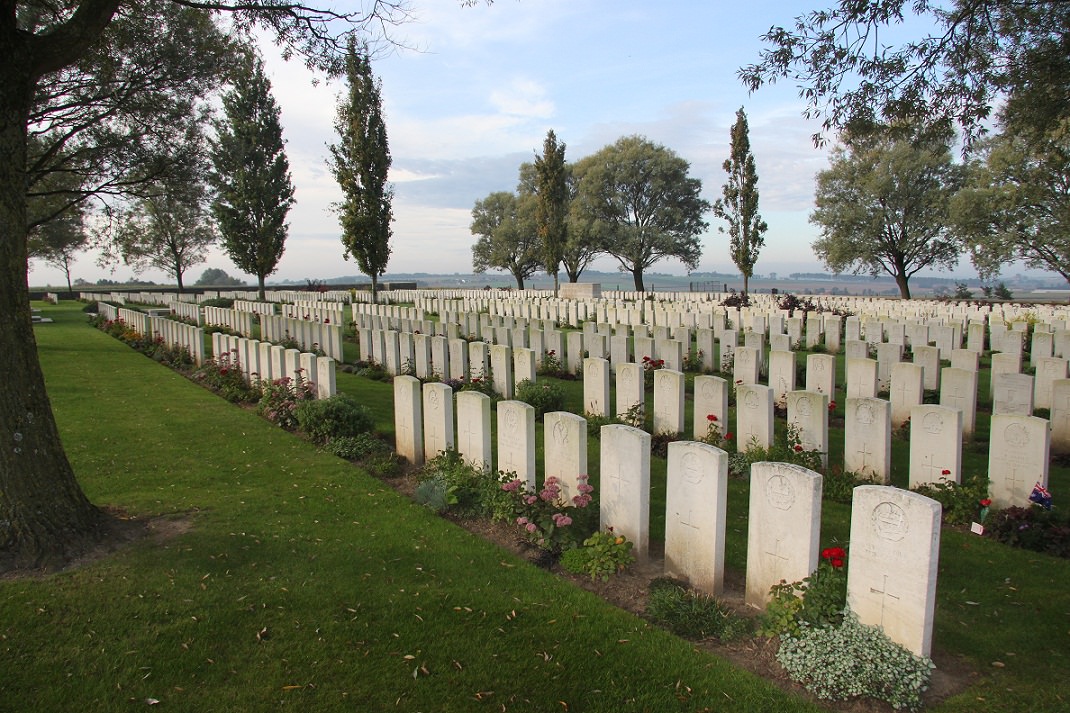

No.1252 John Cyril TRIPP was a 22½ year old Grazier from Muswellbrook in NSW when he enlisted in the AIF on the 26th of January 1916.
He embarked from Australia with “D” Company of the 34th BATTALION (Maitland's Own) on the 2nd of May 1916, aboard the HMAT (A20) Hororata. At Alexandria in Egypt the Battalion transhipped onto the S.S. Aragon for the final leg of the voyage to Plymouth in England, arriving on the 23rd of June 1916.
(John wrote home to his parents telling them of the voyage to England and of his four days leave taken after arrival).
The Muswellbrook Chronicle 19 Aug 1916

The 34th Battalion now became part of the 9th Infantry Brigade (33rd, 34th, 35th, and 36th Infantry Battalions, 9th Machine-Gun Company, and the 9th Light Trench Mortar Battery), of the 3rd Australian Division (9th, 10th, and 11th Infantry Brigades). It would spend the next 4 months training hard on Salisbury Plain to learn the methods of Trench-Warfare.
The Muswellbrook Chronicle 6th Oct 1916

He was with the 34th Battalion when it deployed across to France as part of the 9th Infantry Brigade, on the 21st of November 1916. The Brigade soon moved into the trenches near the village of Armentieres. The area around Armentieres and Houplines was known as a ‘Nursery Sector’ where untested Units could gain experience in a quiet piece of the front. However the 9th Brigade was not in France to have a rest, and so with an aggressive patrolling schedule combined with a series of hard hitting Trench-Raids the 9th Brigade soon dominated their piece of No-Man’s-Land.
He was with the 34th Battalion for the attack on Messines Ridge on the 7th of June 1917, which commenced at 3:10 a.m. with the detonation of 19 huge mines that had been dug under certain key German positions on the Ridge.
On the 1st of July 1917 while accompanying the ration-party (men and mules) carrying the rations to the front line, he was one of several KILLED-IN-ACTION, when a shell exploded in their midst. He and the 34th Battalion Transport-Sergeant were buried in-the-field. He had the following notation recorded in his Service-File: “buried on the south side of a hedge about 100 yards west of the road, just north-west of Messines”.
The Maitland Daily Mercury 14 Jul 1917

His remains were later identified and exhumed by the Graves Services Unit (from Map-Reference o.32.a.9.1) and he was then re-interred in the Messines Ridge British Cemetery, in Belgium.
The Scone Advocate 5 Oct 1917

(Bill Durrant: September 2018)



























Under Construction; 11/12/2014-12/12/2014.